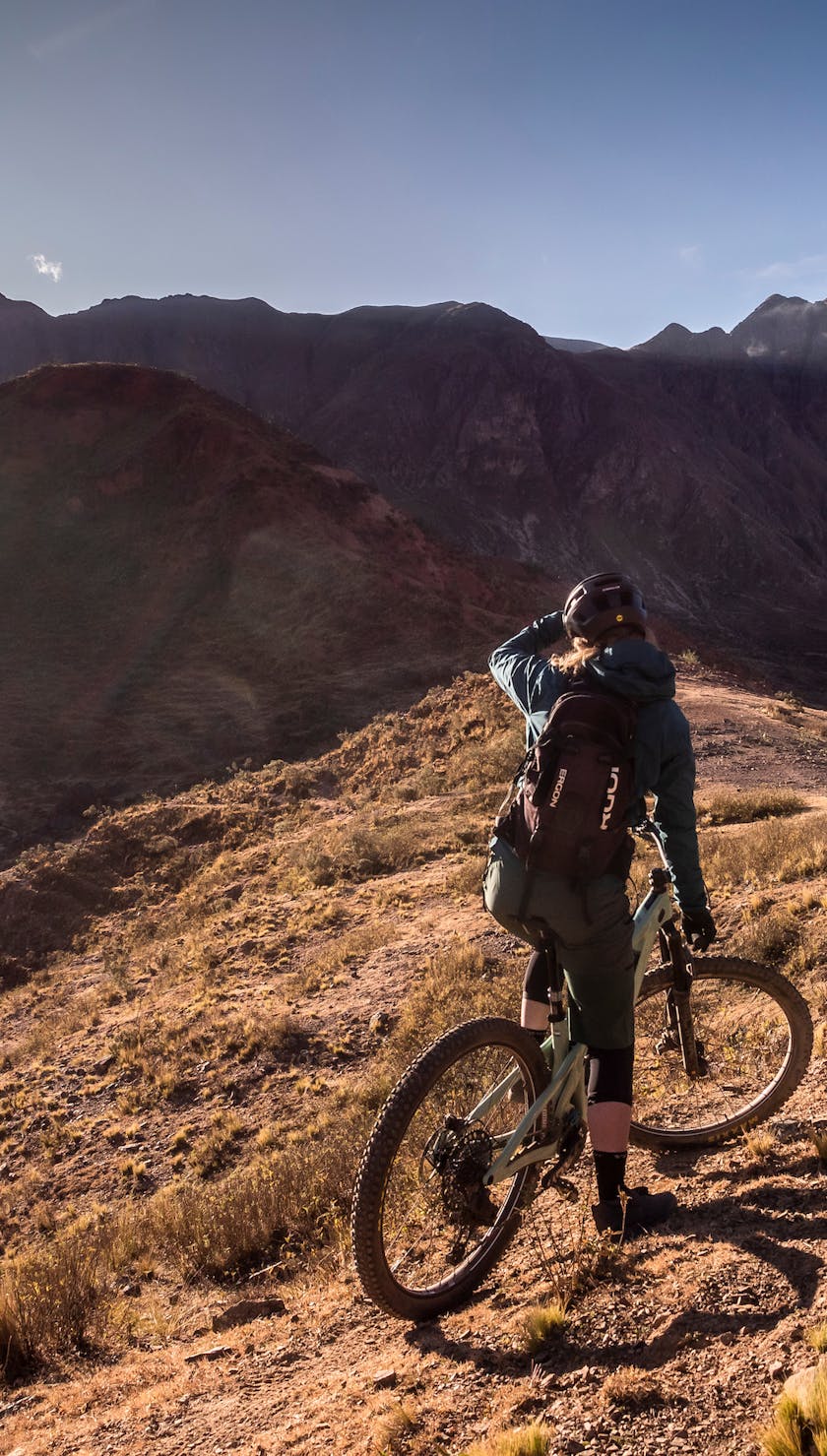
Argentina Badlands
Exploring the Ancient Iruya Valley
We departed Javier’s over seven hours ago, and we’re still pushing forward with the anticipation of a warm meal at our next homestay, a mud dwelling tucked into the mountainside at 10,170 feet. We’ve crossed paths with a half dozen donkeys, and like any long day in the saddle, the details have begun to blur together — like how many climbs we ascended out of a riverbed, how many meat sticks were left in my pack, and how many times I shouldered my SB140. The ratio of pushing to pedaling was not in our favor, yet every little descent reset our outlook.
But in between the tempo of riding and hiking, there are vivid flashes of moments that stay rooted forever. These are the moments that aren’t on the itinerary.
… Like the three amigas, peering over the hillside as we caught the last rays of the golden hour, only to hear their giggles scamper back up the hillside to wait for our return with bikes on our backs. “Aloooooha!” I can still hear their greeting for the gringos.
… Arriving at Alberto’s “Pimp Palace”, exhausted after an eight-hour slog, to run nearly head-first into our dinner hung up on display.
… Riding next to vicuñas in a UNESCO World Heritage site.“Pull the car over, I need a selfie with that baby llama!”
THE CATALYST
Two Brits, an Italian and an American travel a collective 26,600 miles from the comforts of their northern summer, to the Southern Hemisphere. It’s nearing the middle of June, and while their days back home are beckoning all-day adventures with balmy temps, Winter Solstice in Argentina is rapidly approaching.
What is it that draws humans, creatures of comfort, out of routine? Why do we choose to pack up our bikes and every layer fathomable, to leave our favorite trails that are finally hitting their stride, in favor of winter temps and a route that may or may not be rideable?
For adventure, of course. We’re still curious creatures after all, and it’s deeply ingrained in our species to seek out new experiences and information to continuously grow and shift perspective. Besides, this crew really knows how to explore. Being invited on a Dan Milner adventure — Argentina Badlands — you don’t say no to that.
THE ARRIVAL
We find Dan, affectionately known as the Photo Vagabond, sitting outside the domestic terminal of Aeropuerto Jujuy (pronounced hoo-hwee), leaning up against his duffle bag and photopack. There’s an indistinguishable arid touch in the air compared to when we landed near sea level in Buenos Aires the day prior. Surrounded by a cacophony of plane arrivals and departures, Dan appears to be perfectly at home, eyes closed, basking in the afternoon warmth. As we approach, he springs up for a round of genuine embraces with the group.
“Francesco, mate, how you been?” Dan and Francesco exchange a swift match of banter within seconds of seeing each other. Beyond adventuring together in “Around the White Mountain”, Francesco Gozio and Dan frequently intersect on the famous tracks of Finale Ligure, Italy where Francesco is a certified mountain bike guide and event director for the Enduro World Series in Finale and in the Aosta Valley, just across the border to where Dan calls home in Chamonix, France. Seeing each other is like linking up with your favorite riding buddy after a couple of months of being caught up in the rhythm of life — you don’t miss a beat.
I go in for a long overdue hug. I met Dan in my early years working for Yeti Cycles. He visited HQ in Golden, Colorado to document the lunch ride culture, and a picture of my bloodied knee made the editor’s cut. Apparently, that made an impression and exactly a decade later we’re all meeting up on the opposite end of the globe to pick up where Dan left off on a previous trip where he stumbled upon a little village called Iruya. This became the catalyst to find a traverse through remote terrain wavering around 13,000 feet in elevation, to end along the banks of the Iruya River nestled within the dramatic antiplano landscape.
Francisco (not to be confused with Francesco), our local guide, pulls up in his VW truck to load the crew, including Jacob, our cheery videographer who doubles down on British banter. ¡Vamos! It’s time to hit the road.
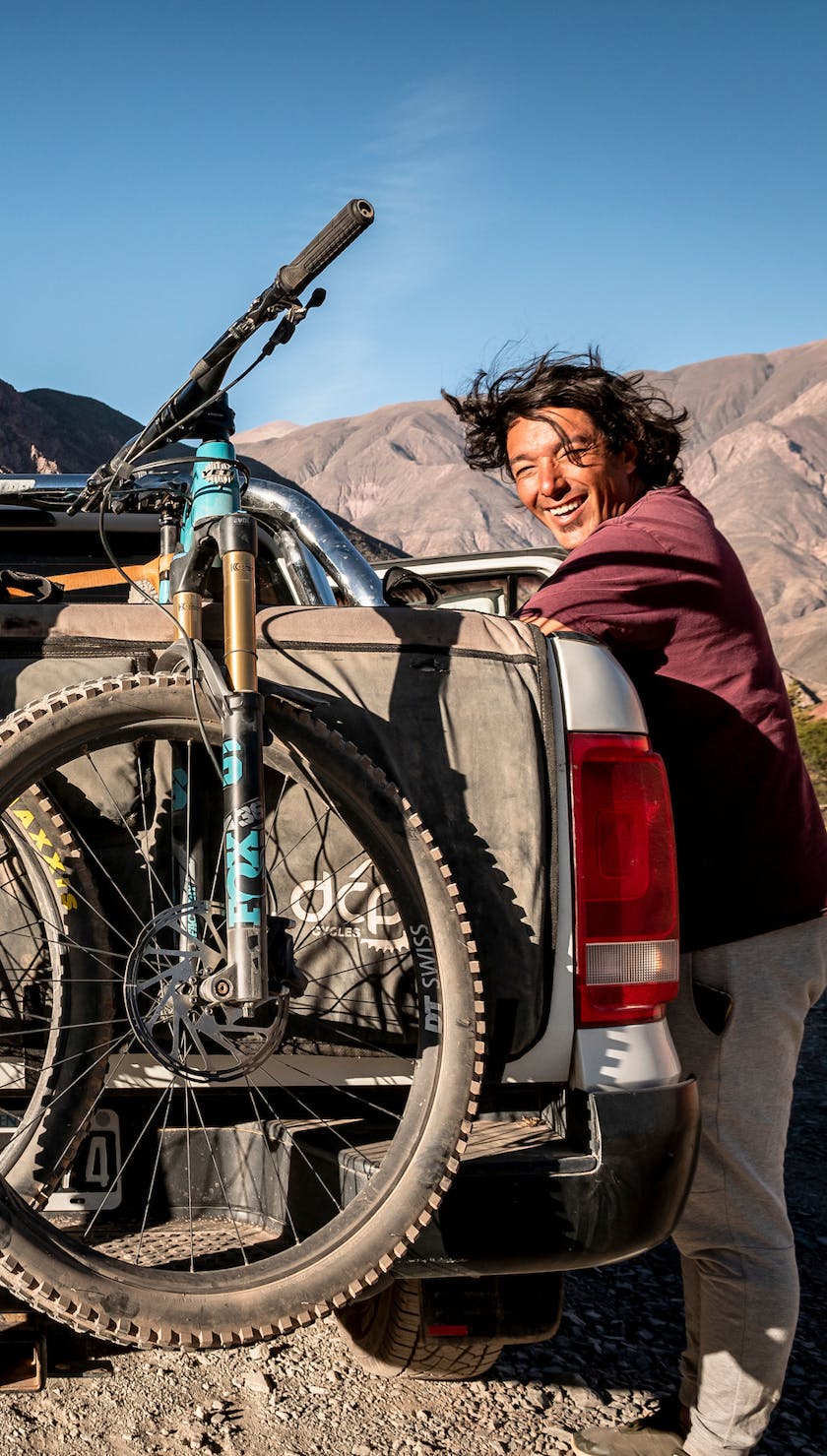
We drive another hour to Tilcara, situated at 8,807 feet, where we prepare for the next couple of days and sample the local trails that Francisco has been exploring since childhood. Francisco drops us off with Augustine, his partner of Jujuy en Bici, the local mountain bike outfitter, and owner of Sumalagua, a rustic bed and breakfast that would serve as our launching pad for what’s to come. We build our bikes as the sun drops behind the mountains, the prickles of the giant cactuses catching the last minutes of light, then walk to town to sample the regional cuisine of wine, humitas, quinoa, and llama. The Euros are complaining about being short of breath, and so the banter begins.
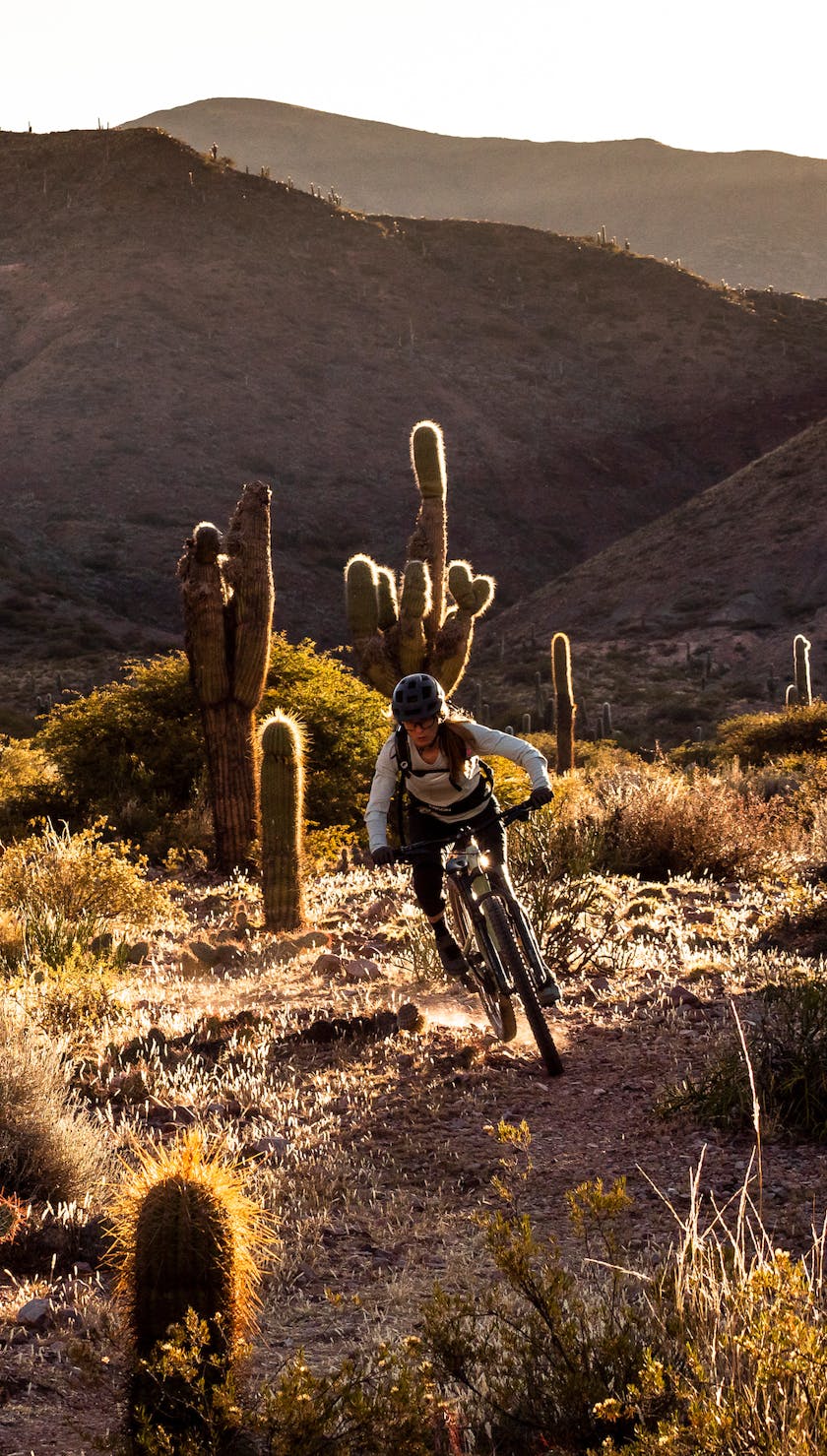
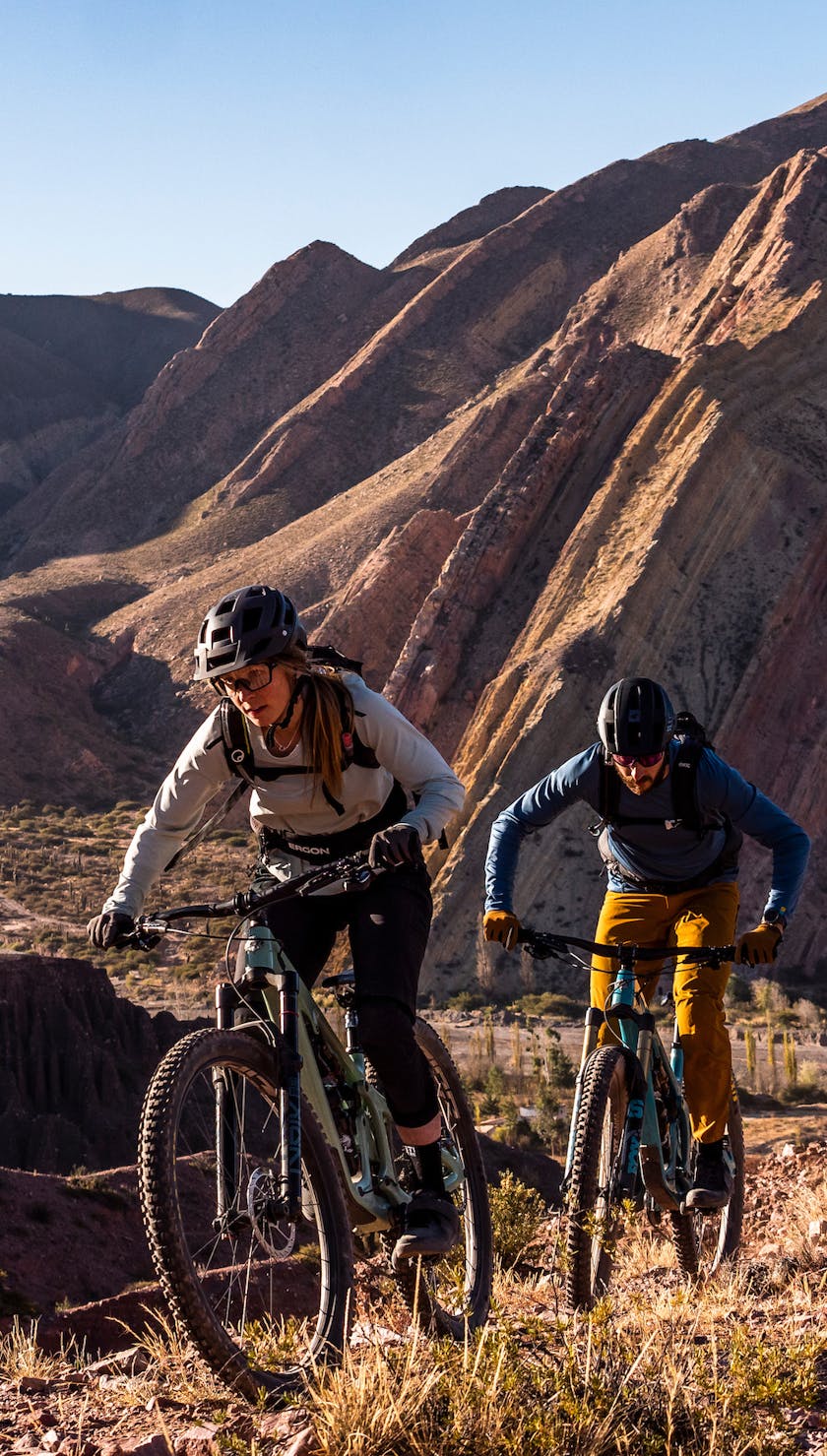
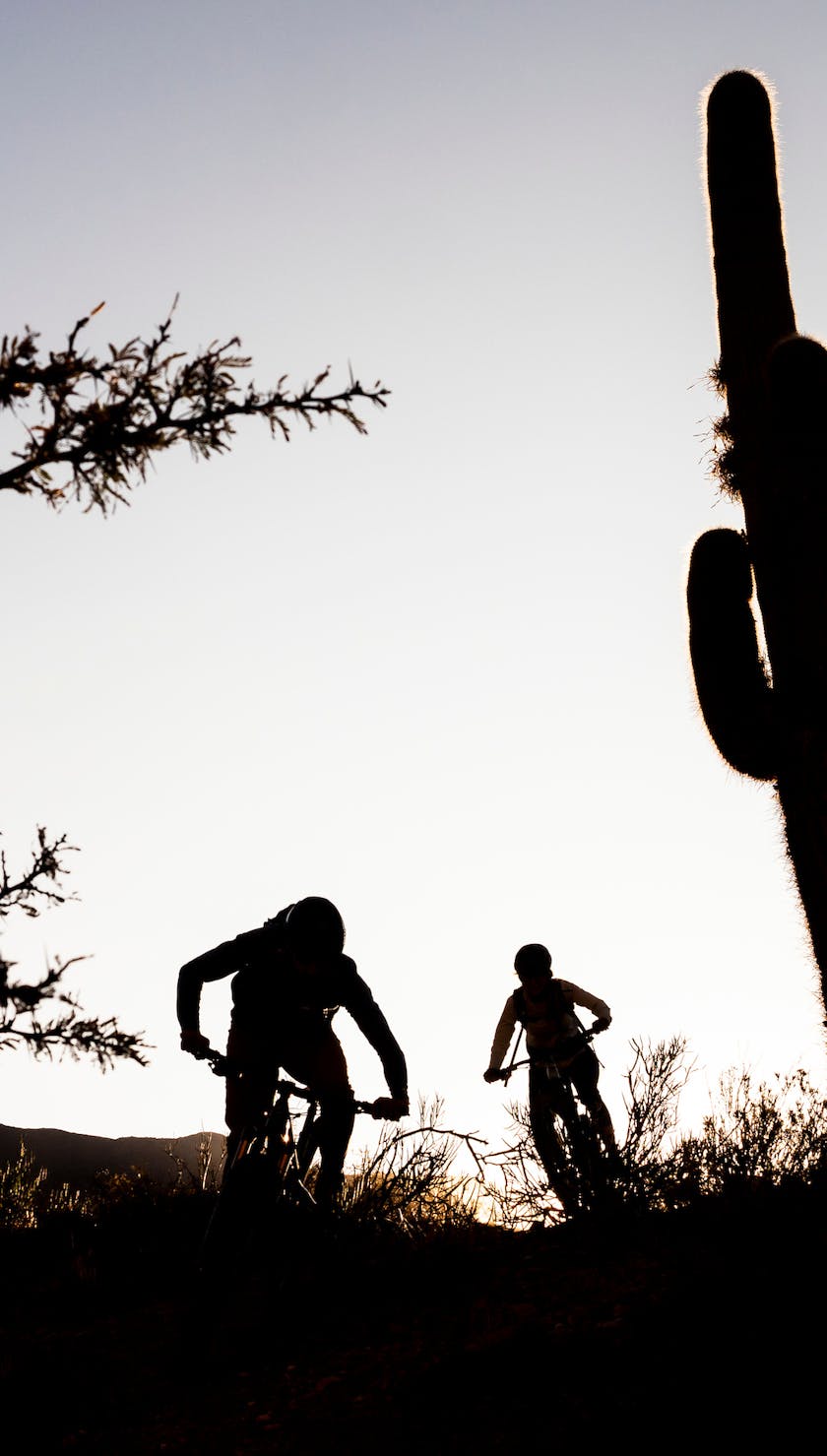
RODEO, COLORADO
It’s 6:00 a.m. and we are cresting a mountain pass at 15,010 feet. To commemorate, I jump out of the truck and do 15 jumping jacks. Despite living in Colorado for the past 18 years spending the majority of my free time scampering around the high country, I had never been above Colorado’s highest fourteener at 14,439 feet. Our drop-in for the first day of the traverse began at the equivalent of Mount Elbert’s summit. No one else seems as amused with the below-freezing temps and hollow air, so I jump back in and we carry on to arrive at the end of our creature comforts of warm air blasting inside the truck.
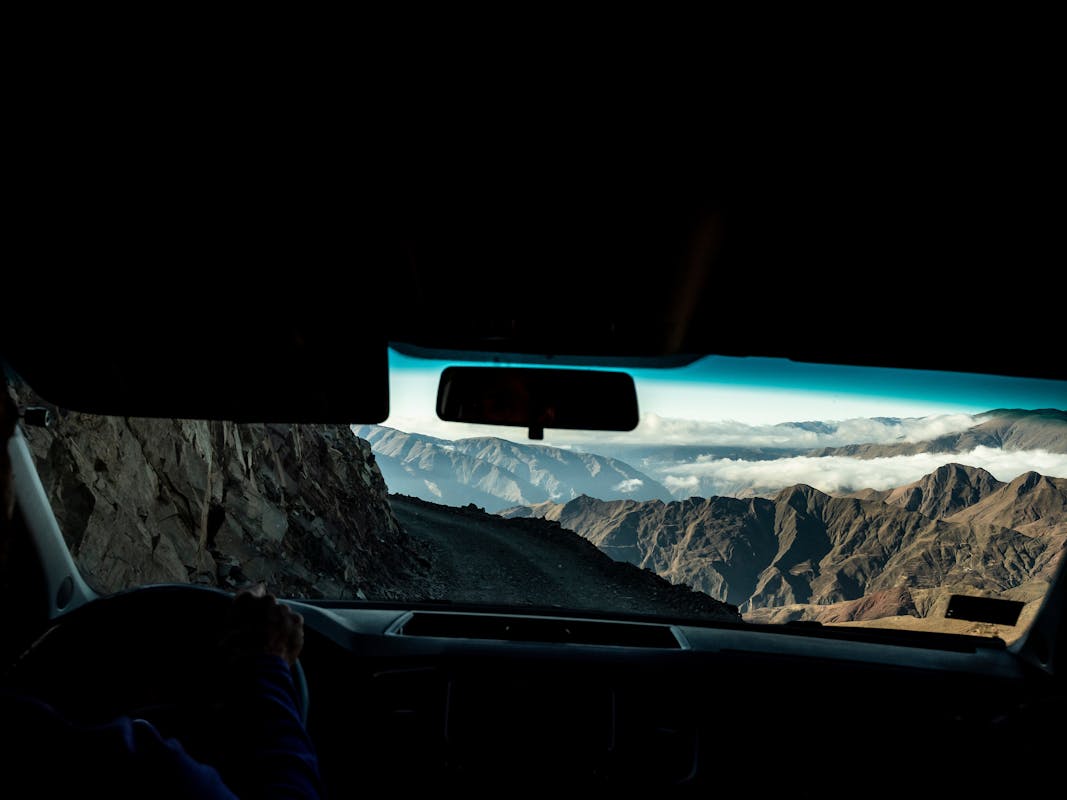
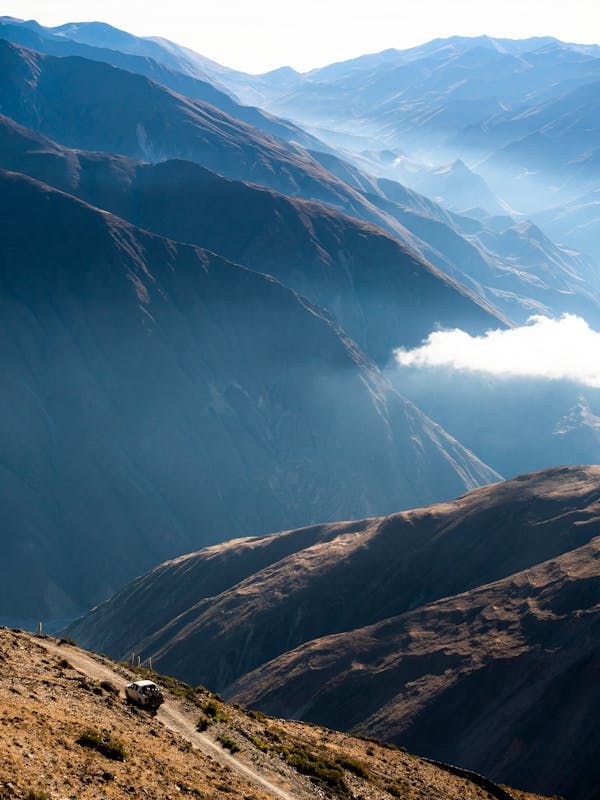
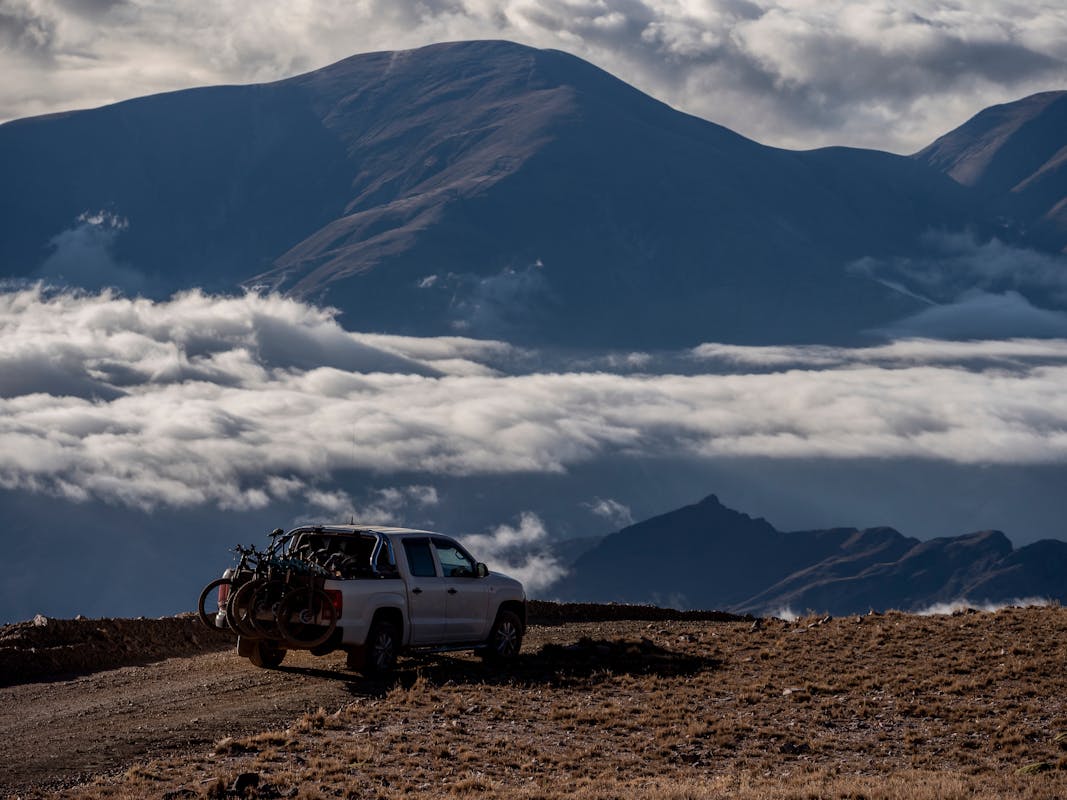
With fully loaded packs hoisted onto our backs, we drop straight into a descent carved into the side of the mountain. Francesco feels immediately at home on the exposed shelf that is straight out of his playbook for classic European singletrack, nose picks and all. I, on the other hand, take some time to warm up to the blind rollovers as the trail follows the contours of the exposed mountainside. But as the morning sun begins to warm us, the years of racing enduro courses blind soften my white-knuckle grip on the bars. I ease into the moment and find flow amongst the rock and the jank as my big 29er wheels do the work. I take in the mighty vistas, pinching myself that I’m riding my bike in the middle of the Andes again.
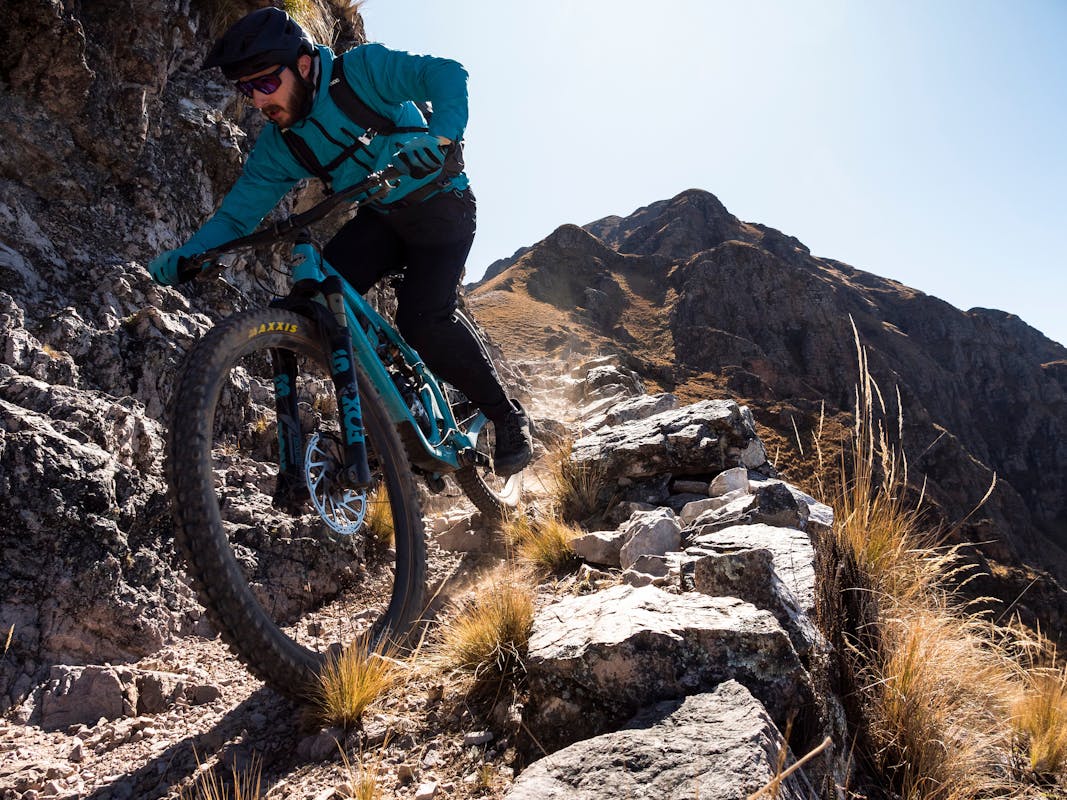
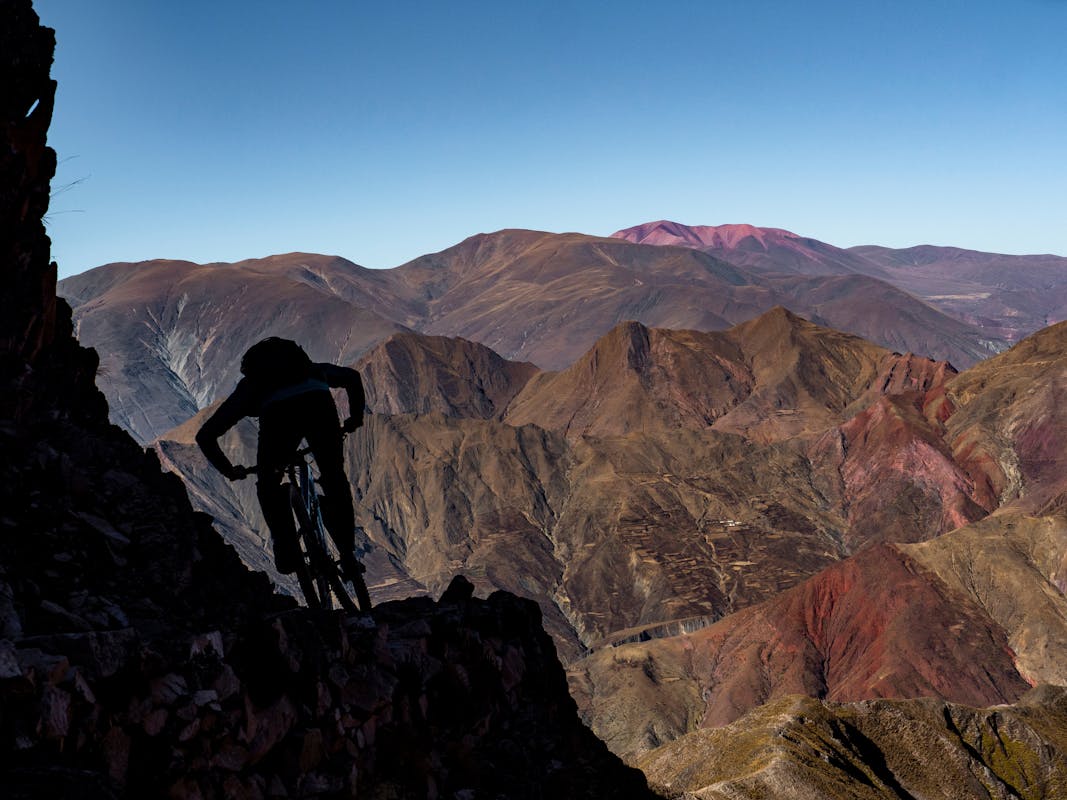
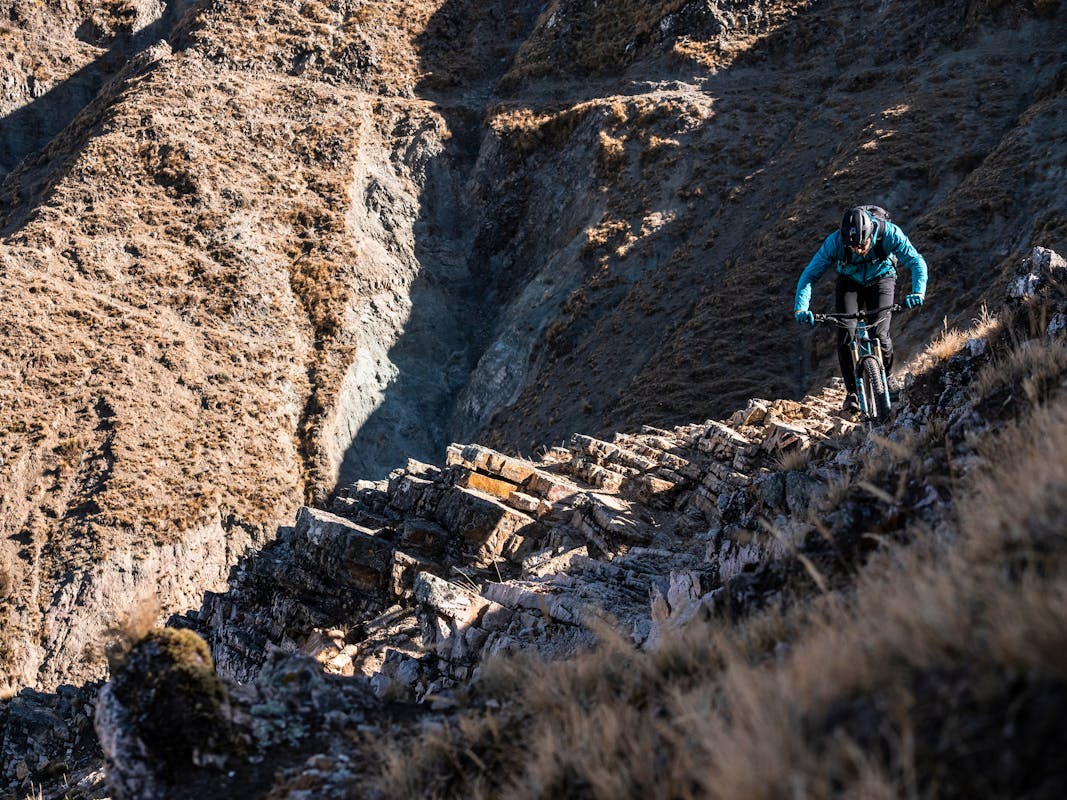
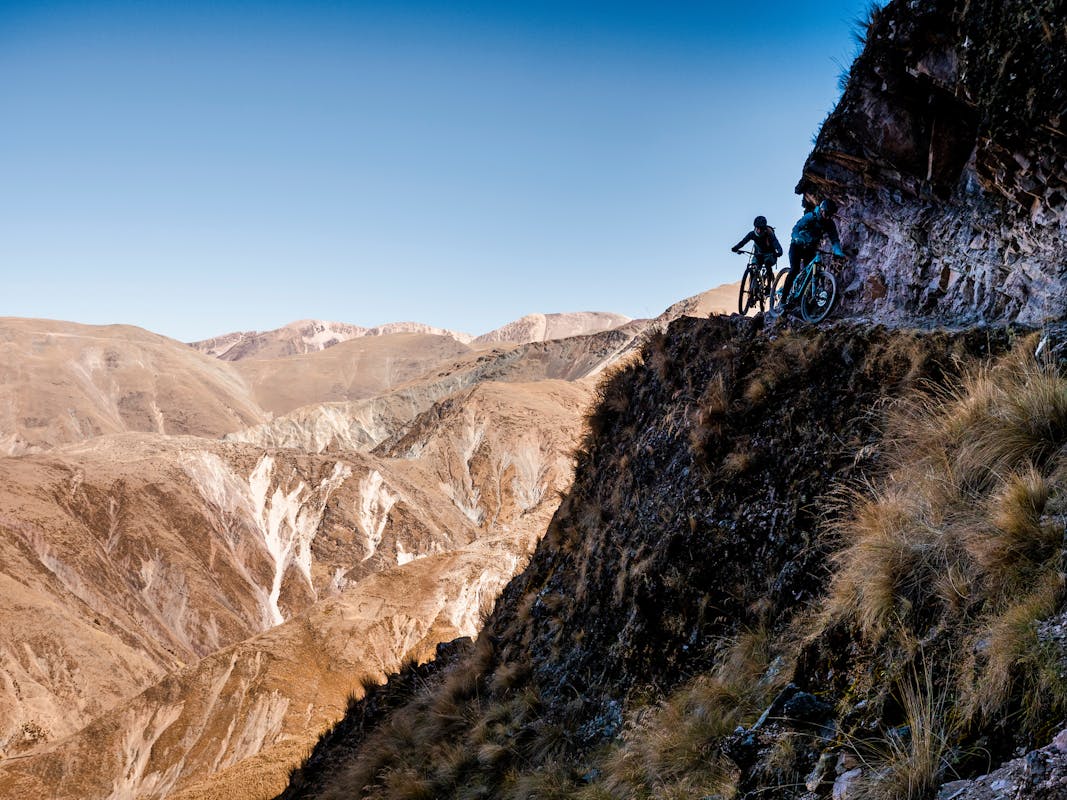
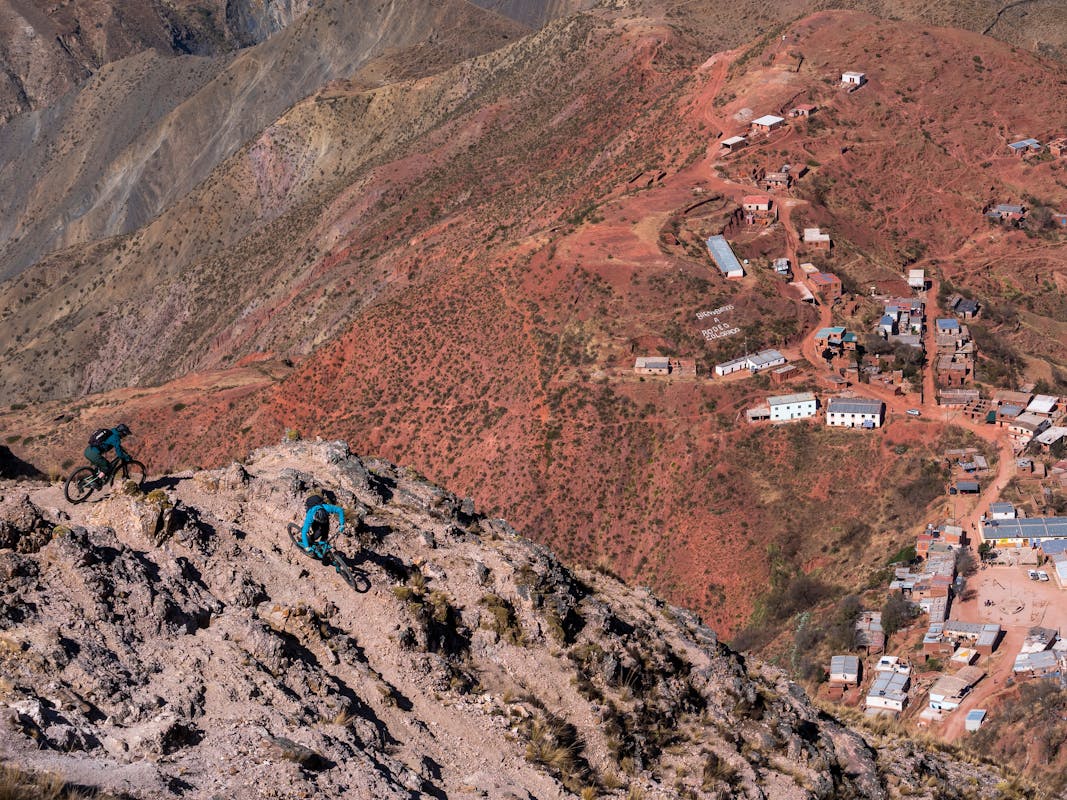
The traversing devolves into a steep fall line with periodic steep switchbacks, and it’s on — Francesco is in his element. Dan is pipping his back wheel for good measure. At this point, a swift glance to the rotor would become an instant branded tattoo. As we get closer to town, I wave to a local who is tending to the terraced cultivation on the hillside. We are close to civilization again.
Right as we spit out onto the road, a moped buzzes us, a herd of goats is ushered up the road, dogs are yipping, and a pair of donkeys seem dismayed by the commotion. I’m certain Dan and Jacob are freaking out about the photo op. We coast down the road to the center plaza of a small town named Rodeo Colorado. In a sense, I feel right at home.
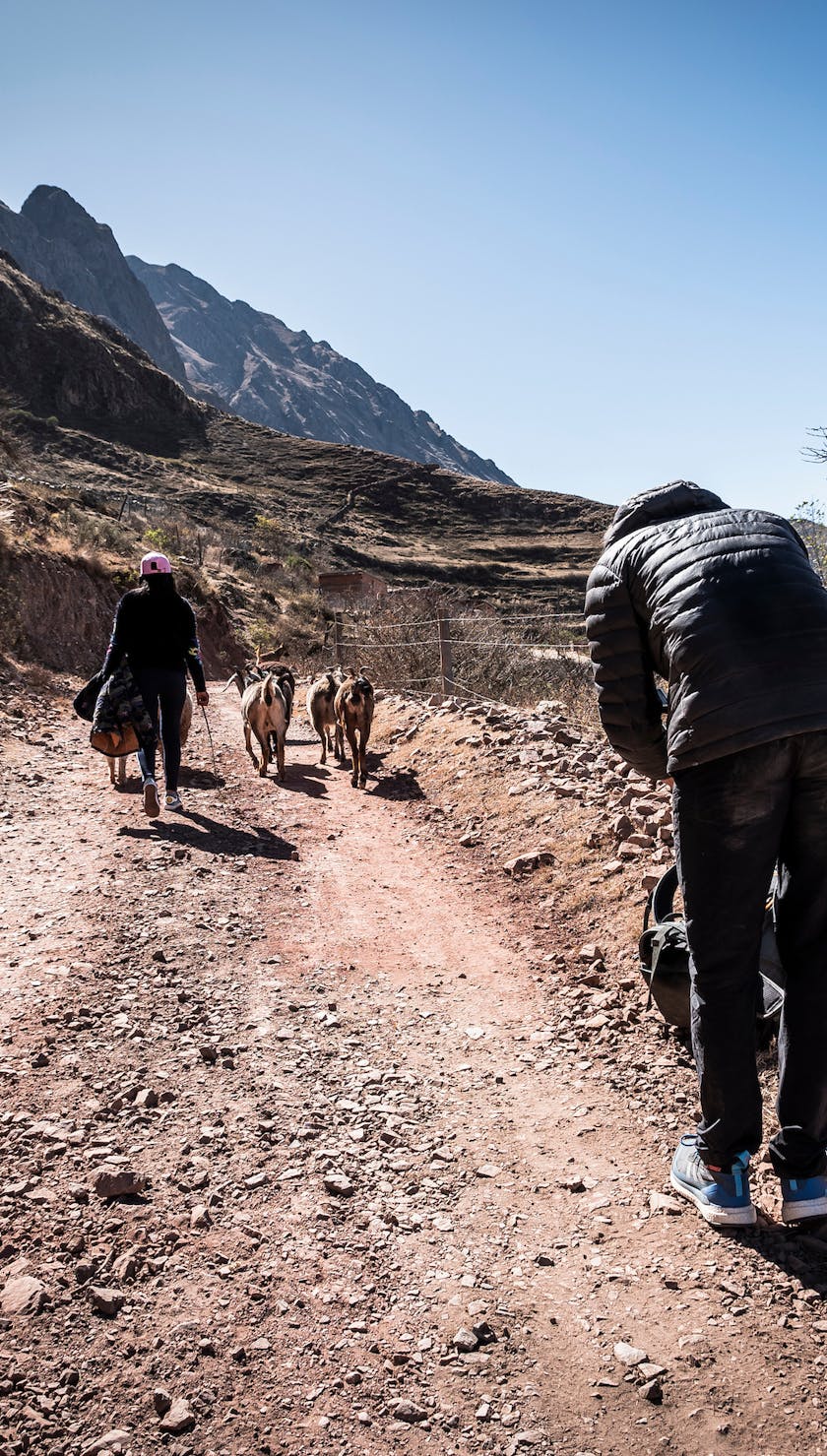
We stumble upon an afternoon celebration of sorts. Festive music blasts through the courtyard and primary school kids are chattering and playing about. Entirely decked in turquoise and shades of sage and evergreen, we don’t blend in with the environment or anybody around us. Heads turn, so I feel the only way to cross the unspoken barrier is to ditch my bike and join the kids on the playground.
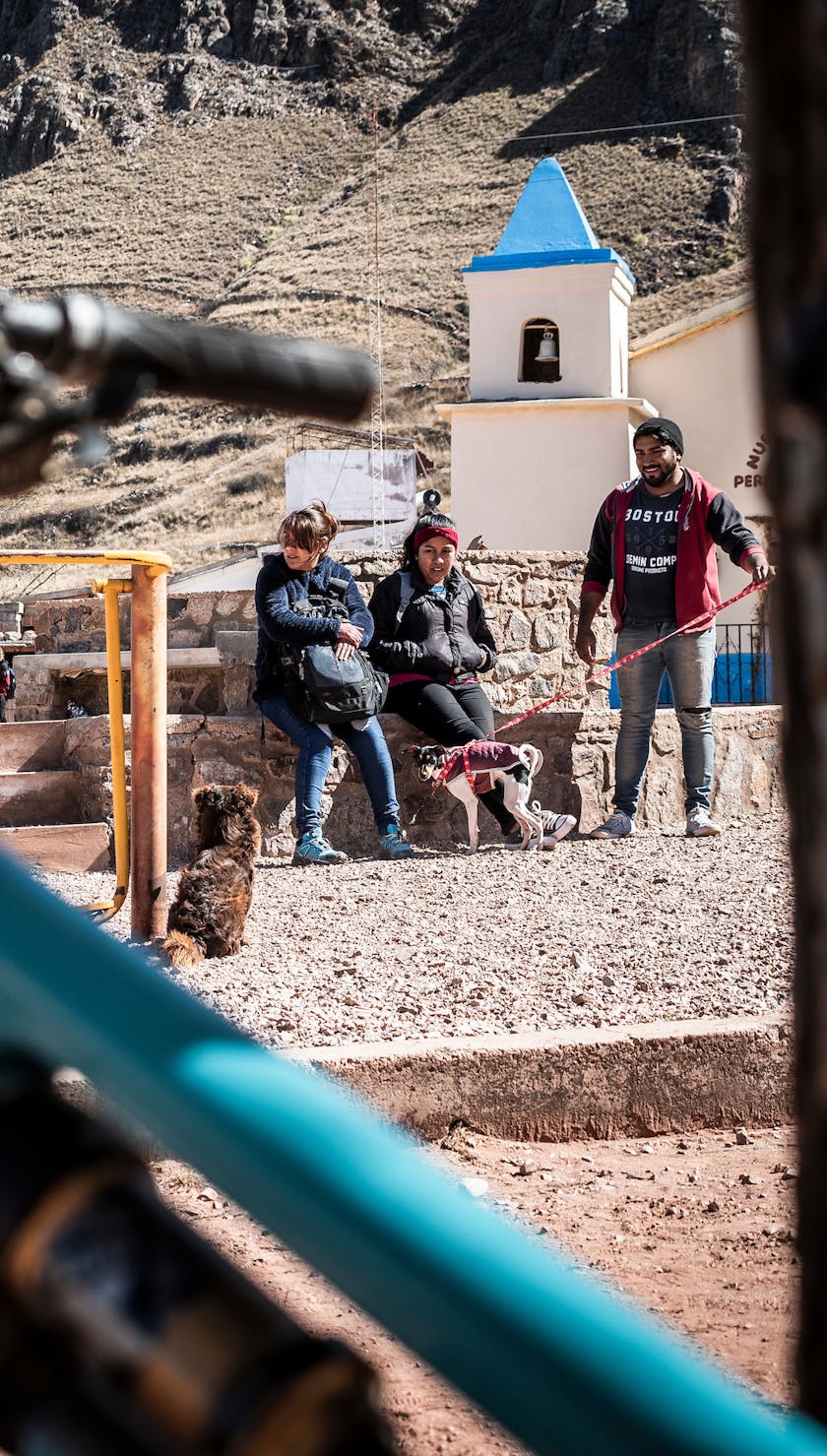
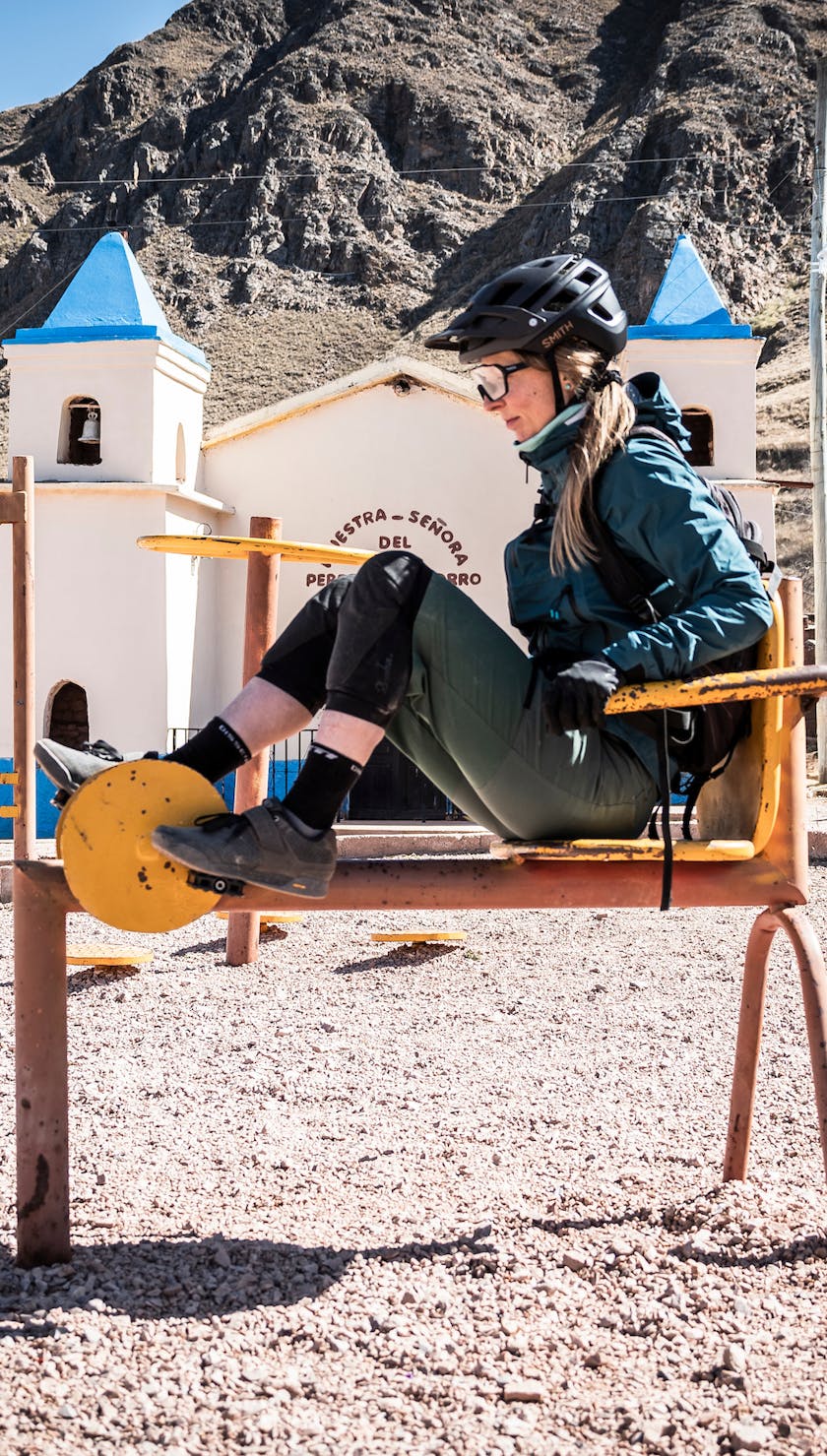
It’s a bit past lunchtime, so we saddle back up and coast down to our first homestay of the trip. Javier has graciously opened his door to our whole crew and is in the kitchen chopping up vegetables for dinner tonight. I hear that llama stew is on the menu. It is evident that Javier has played host to many other hikers and travelers with the room prepared with colorful blankets and the table already set and more than eager to share his amenities. We hear that Javier’s the only guy in the entire valley with Wi-Fi. When we departed Tilcara for the mountains, I gladly watched my bars of reception diminish to “No Service”. I instantly felt relieved, a feeling that would last for the next three days to come. One of the things I crave the most while traveling is to completely disconnect from a world of connectivity. As beautiful as it can be to share a moment with someone else via a text message, picture, or video from anywhere in the world, there is also something satisfying about sharing that moment with just the people you are present with.
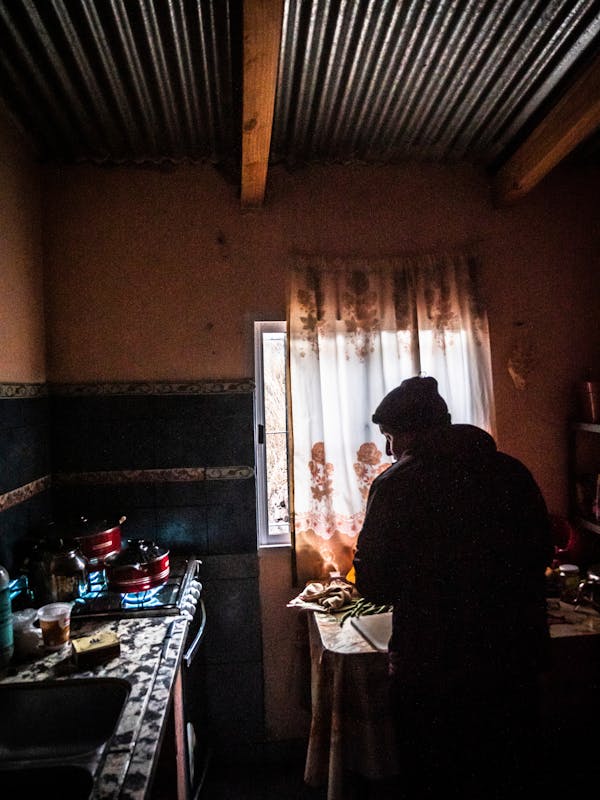
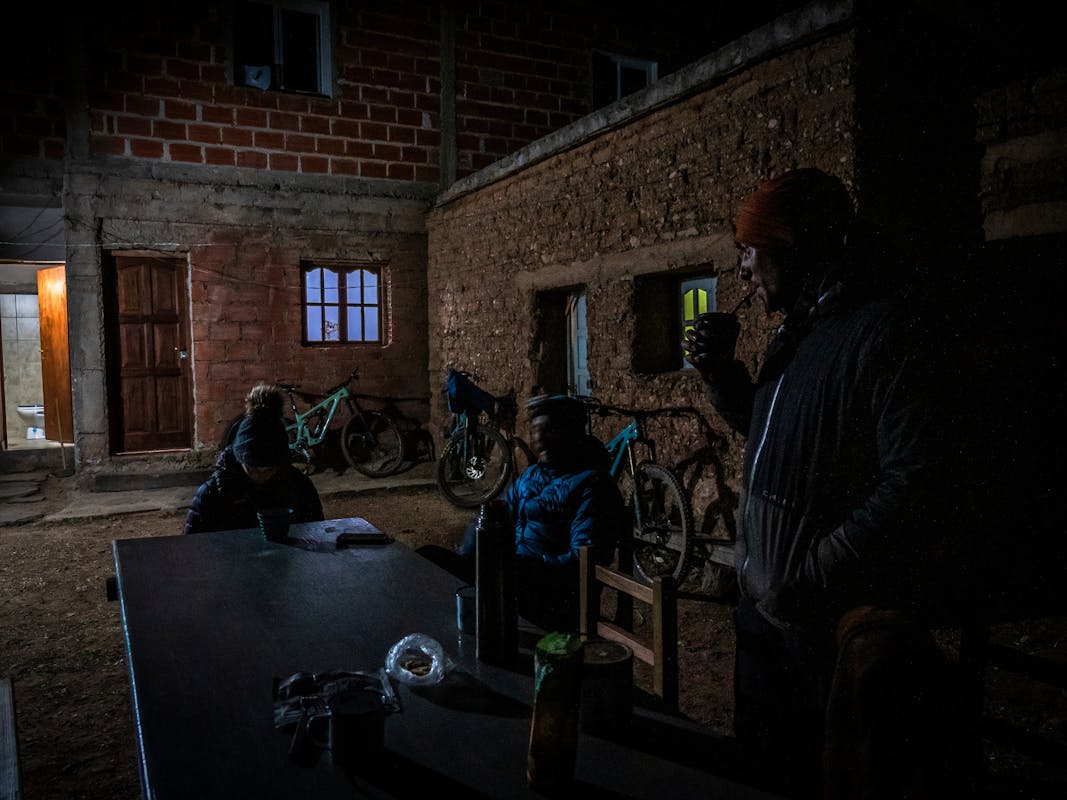
But I want to be an appreciative guest, so obliged, I ask Javier for the password. And for good measure, send my dad a text. I start typing out the full story about the three amigas I met that evening, shy but full of energy and eager to interact.
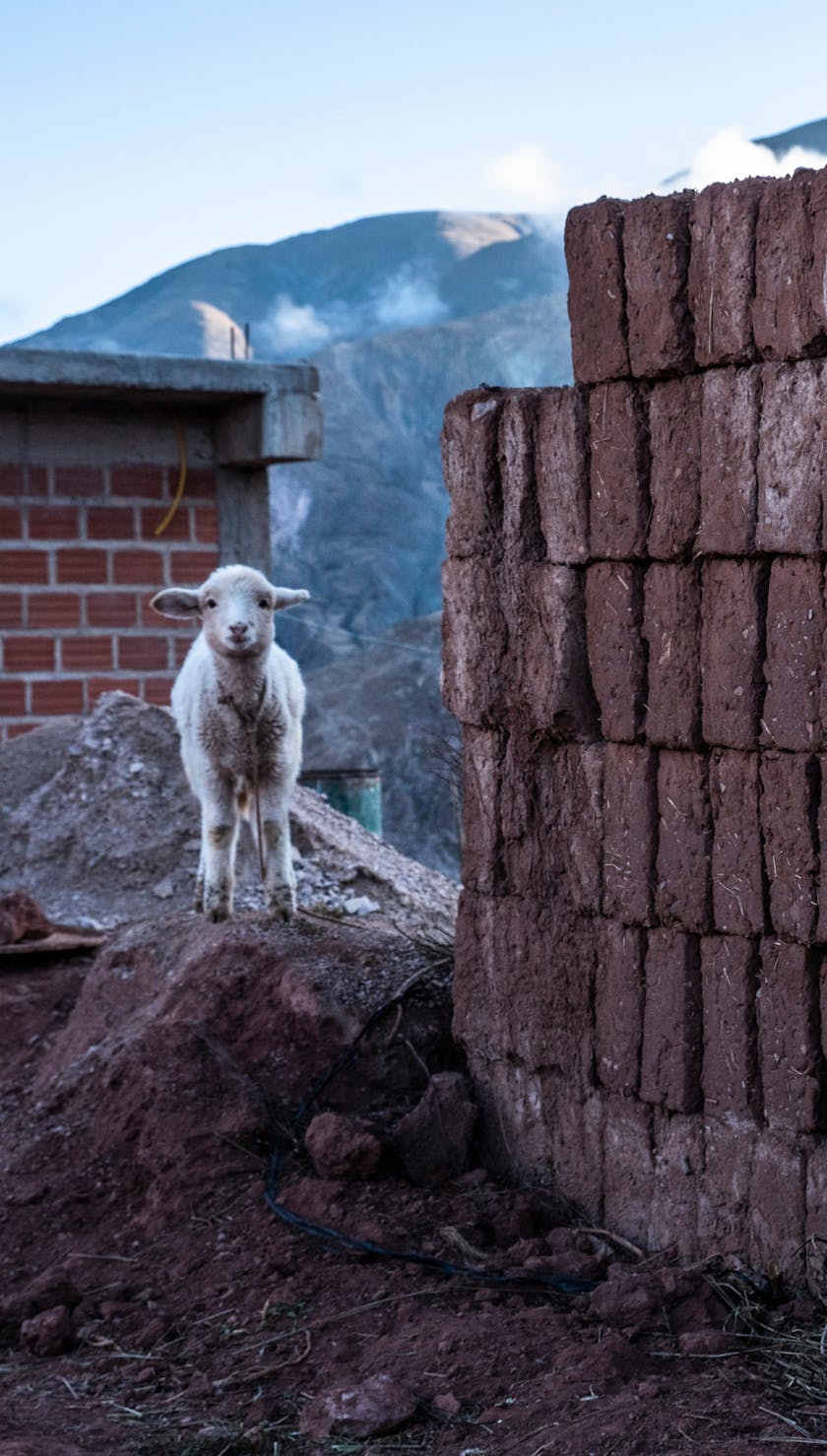
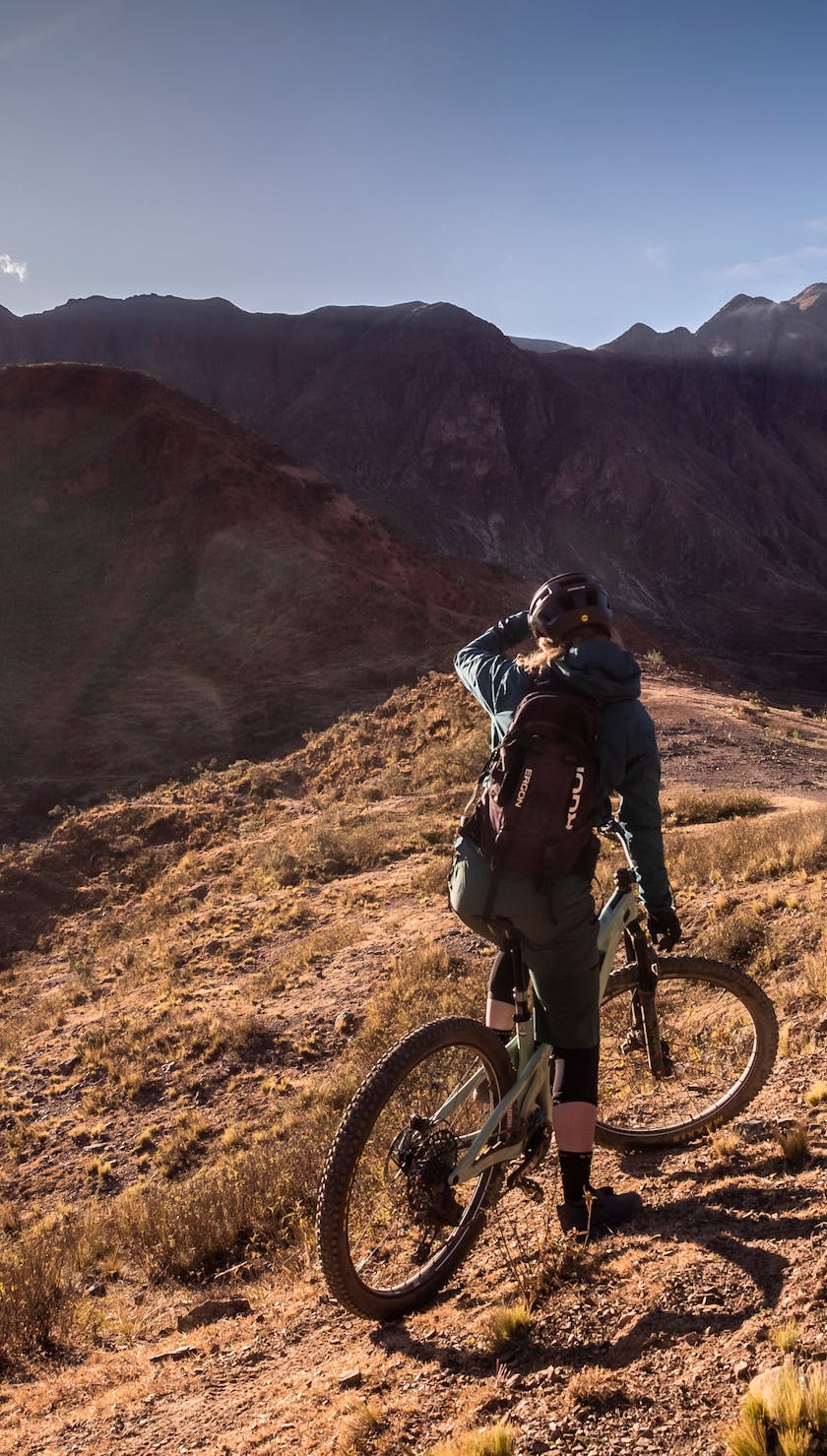
Peering over the hillside as we caught the last rays of the golden hour, their giggles scamper back up the hillside to wait for our return with bikes on our backs. “Aloooooha!” I can still hear their greeting for the gringos.
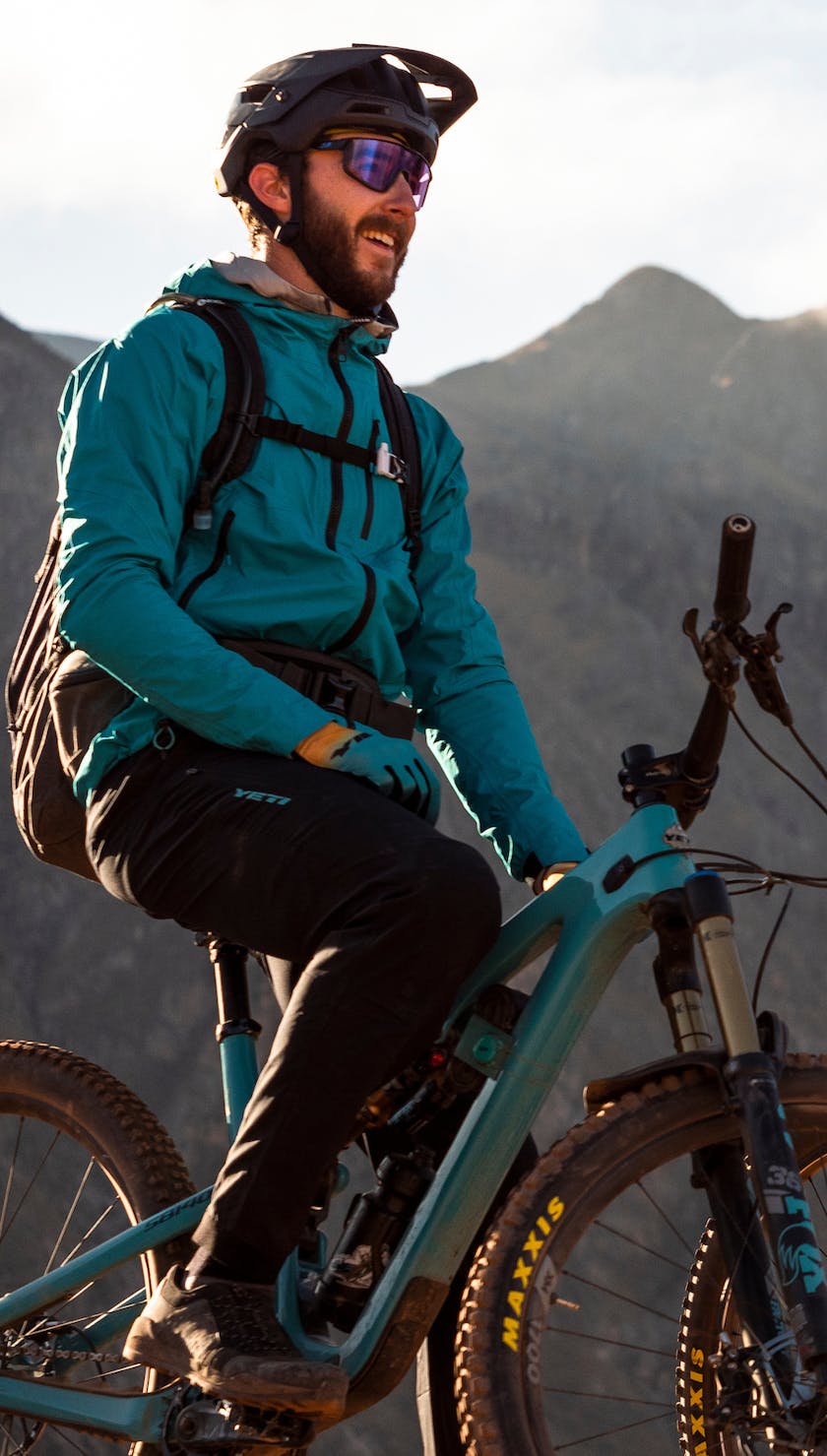
“… I coaxed one of them over so I could pet her lamb that was tied up in front of the house. The little girl ran inside and back out to ask me what time it was (another reminder that I should have taken Spanish in high school instead of German … BUT Google Translate saved the moment. We chatted about the time of day, how old she is, her pet lamb’s name. It was such a special moment! I’m so excited to be here, Rodeo Colorado is stunning. I can’t only imagine what the next two days will bring- prob no service after this, I’ll let you know when we’re off our traverse! Ciao ciao!”
Sitting outside, my numb fingers push send. My picture doesn’t go through. That would be the last text I send until we reach the end of our traverse.
ALBERTO’S PIMP PALACE
These are some of the shortest days of the year in the Southern Hemisphere, and they dictate our pace. We spend long hours in the dark sipping tea and talking, When sunrise comes swiftly at 8 a.m., I wake up buzzing for what’s to come, keen to get the blood flowing after a night bundled up in layers, in a sleeping bag, under a pile of dense blankets. I learned my lesson from the day before and start today’s ride with my warmest gloves.
Adiós! We wave goodbye to Javier and thank him for a most hospitable stay. Just down the road from the house, we embark on a trail that will take us on a journey until sunset.
A low mist has settled into the valley, and immediately, my tires hook up. Compared to yesterday’s terrain, this feels foreign. The silty, vibrant red dirt has traction — the kind that has you smearing cream cheese turns with your rear wheel every time you push into it. My hands may already be going numb but my rosy cheeks and playful maneuvers are indicative of pure elation. It feels too good to be true. Two for two on starting the day with a big descent. But it would not end there.
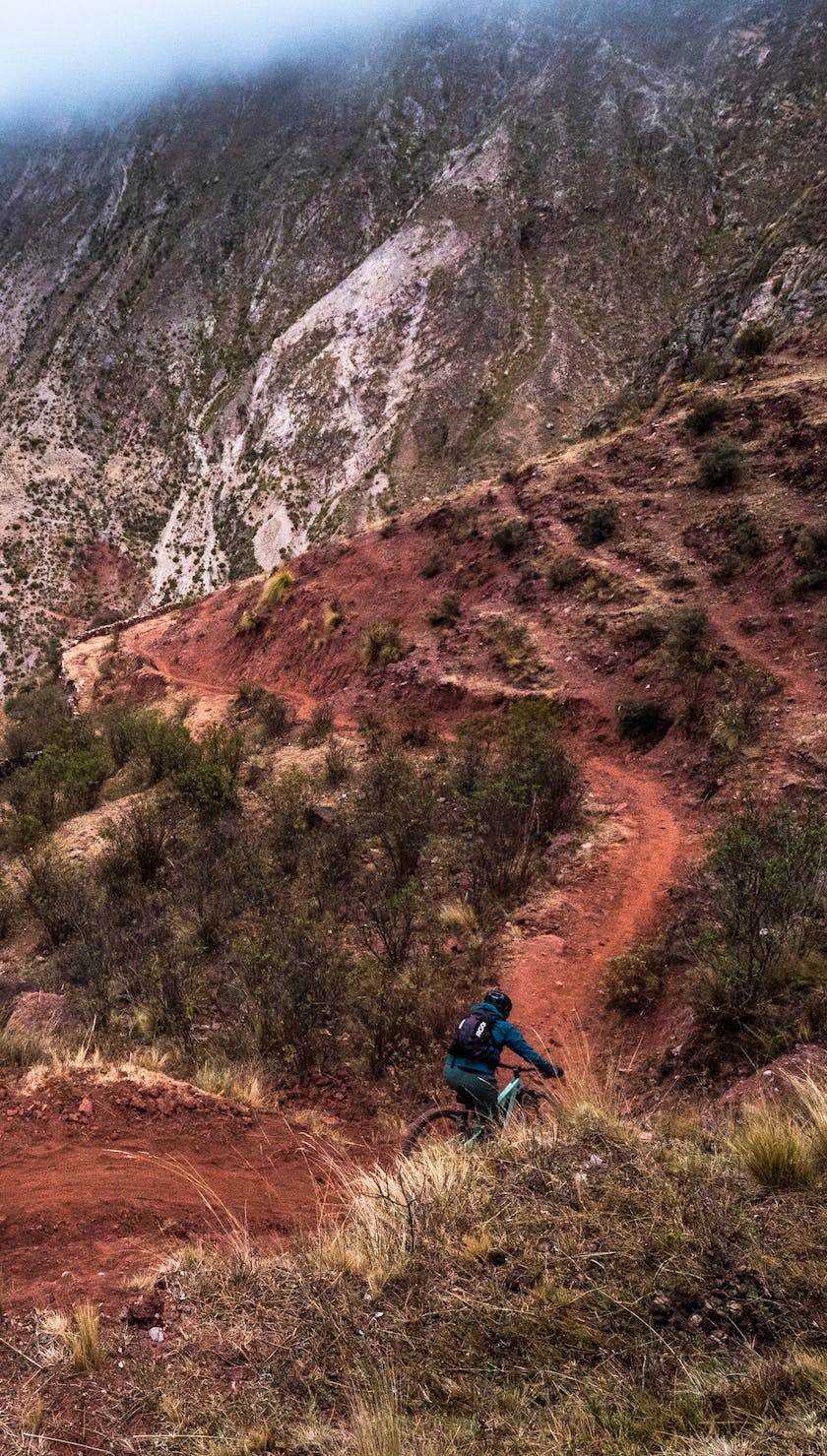
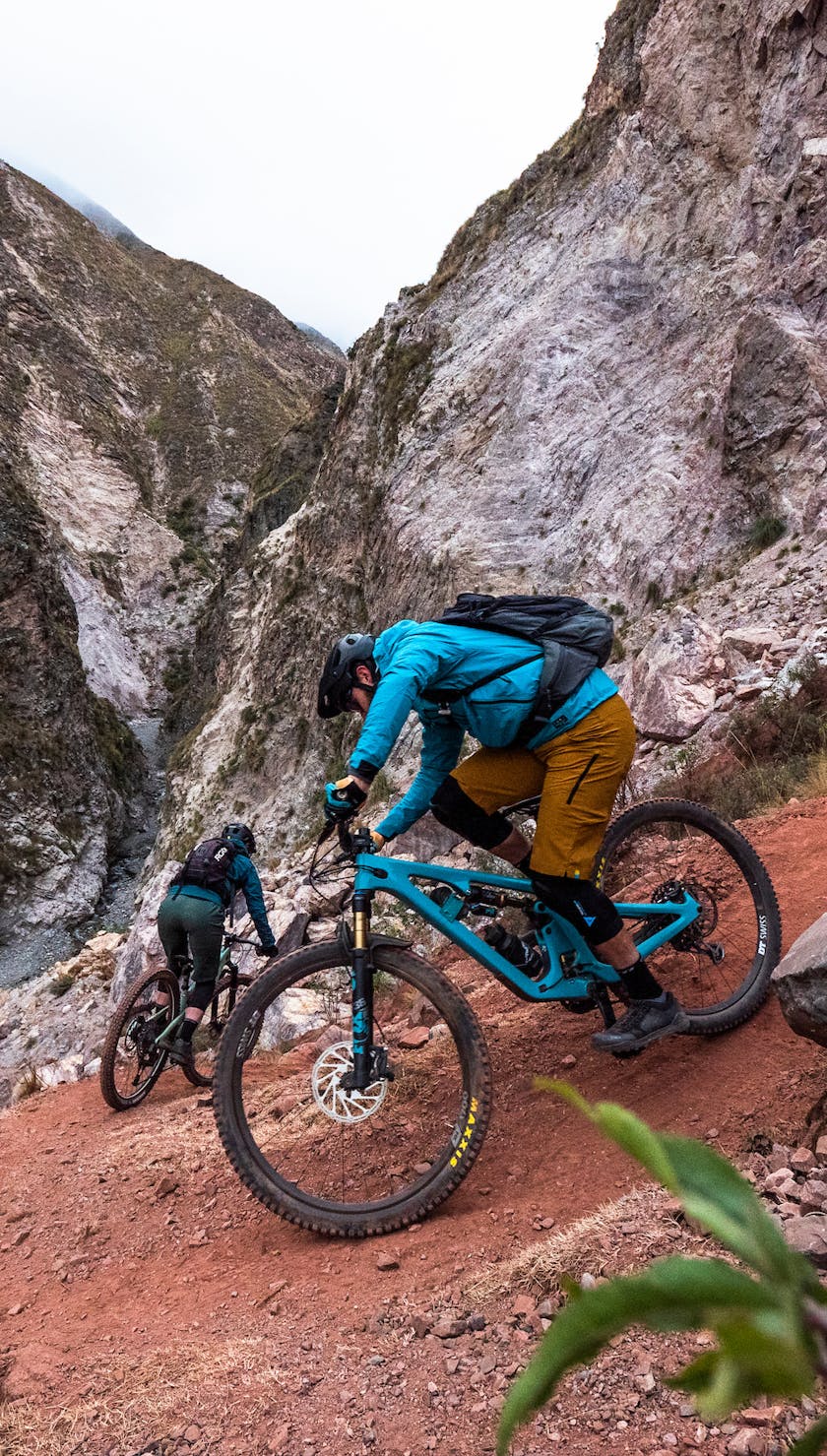
We hit the valley floor, and it’s an immediate transition to a hike-a-bike. This becomes an anticipated trend, and hoist-by-hoist, the carbon frame feels less forgiving resting on my traps.
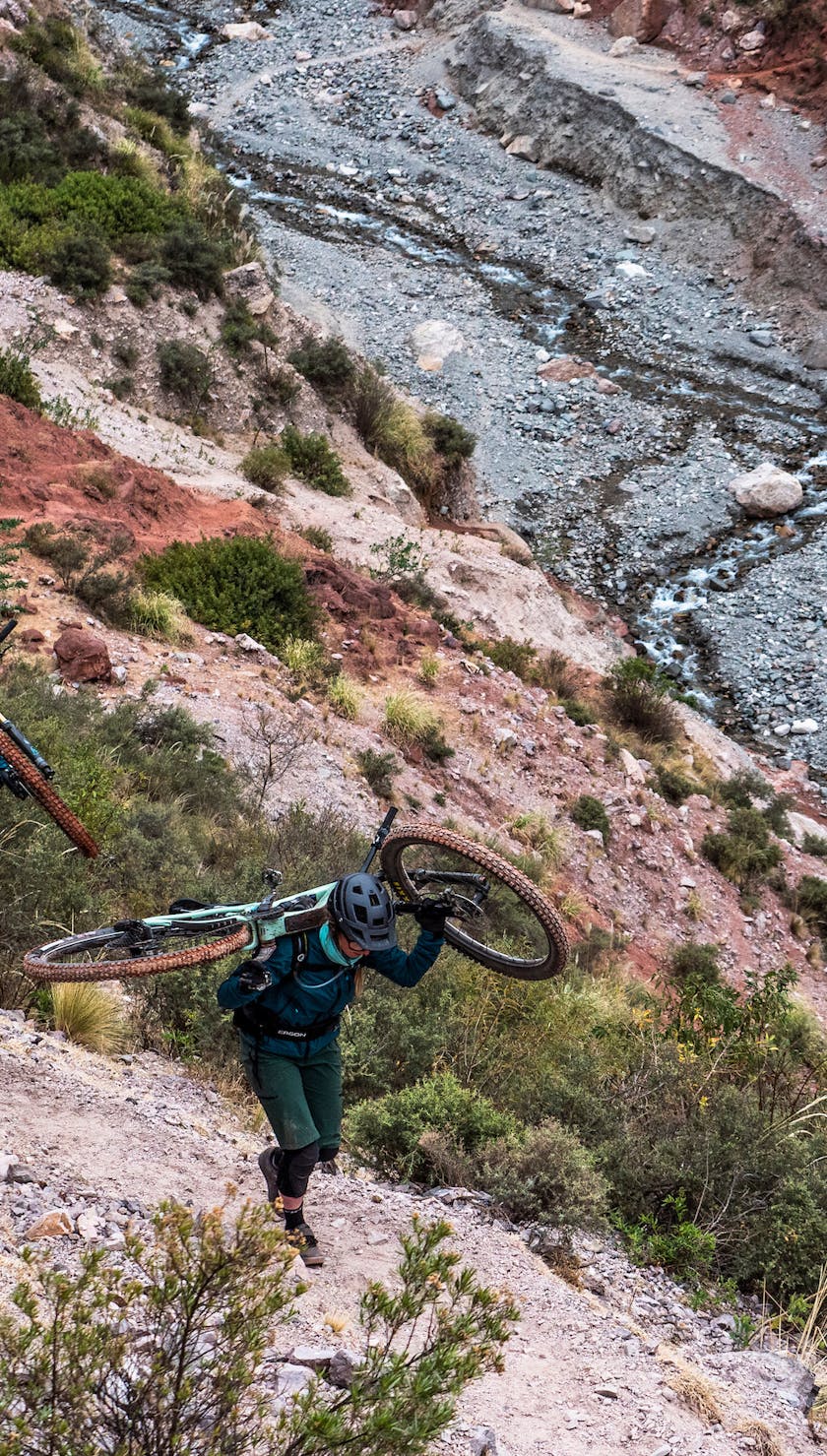
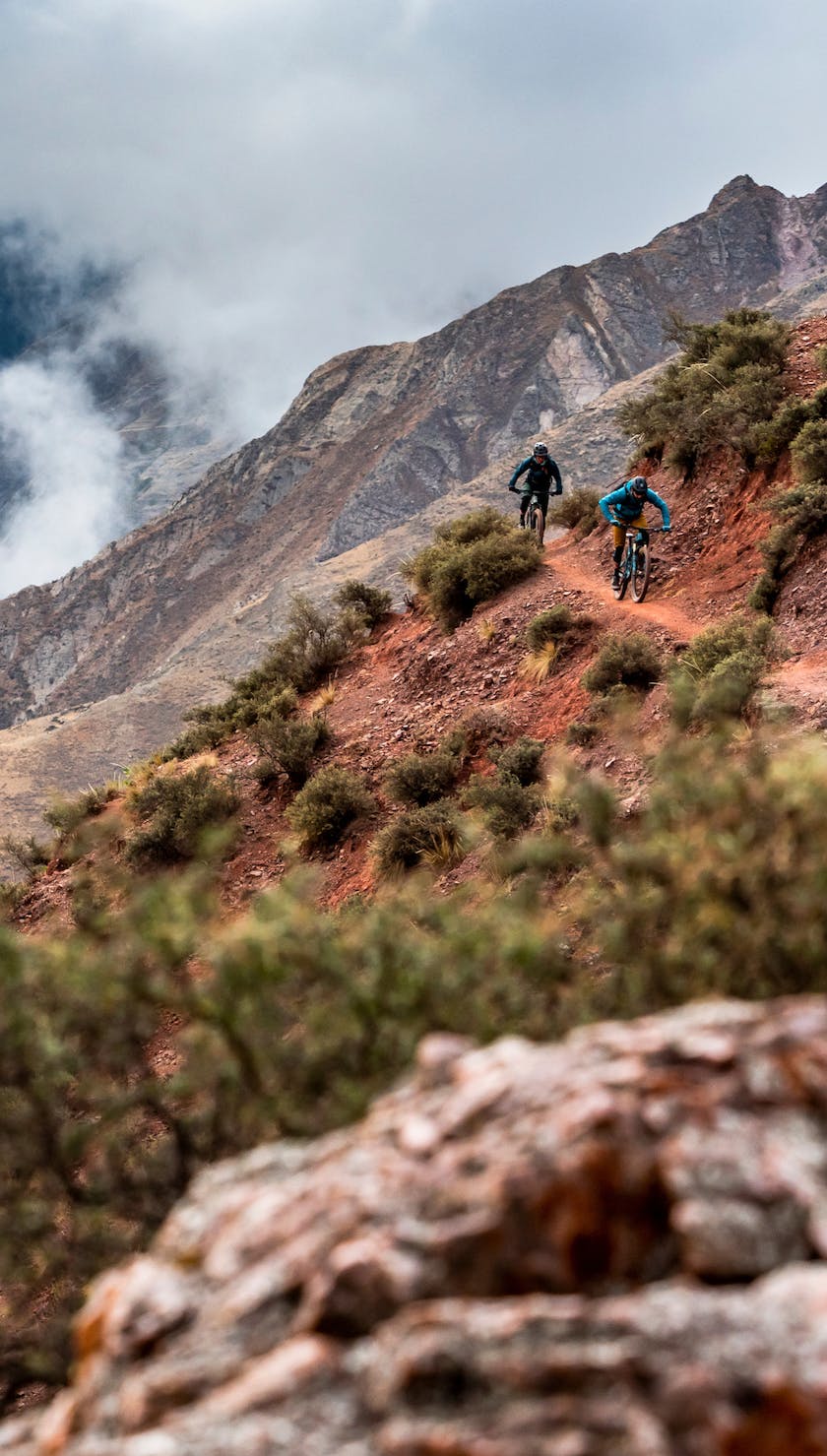
Gaze directed at my stem, I hear Dan ahead, giddy with excitement. “Would you look at that!” Soaring above us is a massive condor. The majestic Andean condor is one of the world's largest flying birds, with an 11-foot wingspan and weighing up to 33 pounds. They have become increasingly rare in northern South America due to hunting and habitat loss but here we were, right in the middle of its nesting grounds.
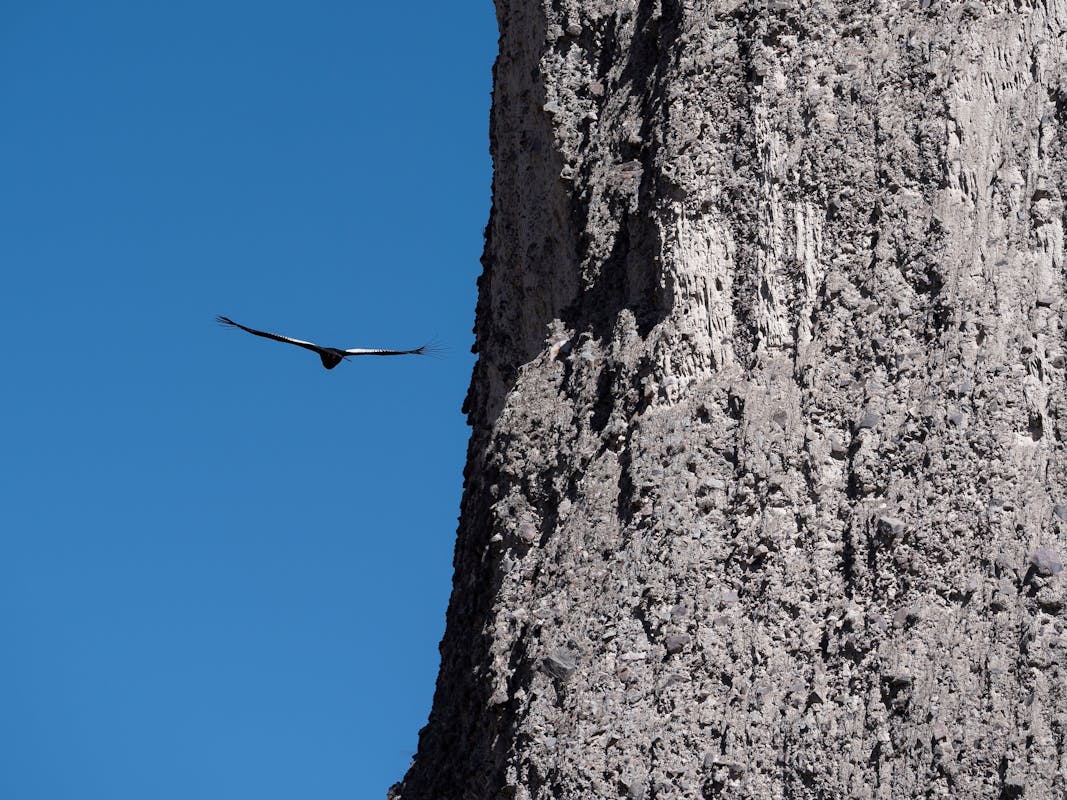
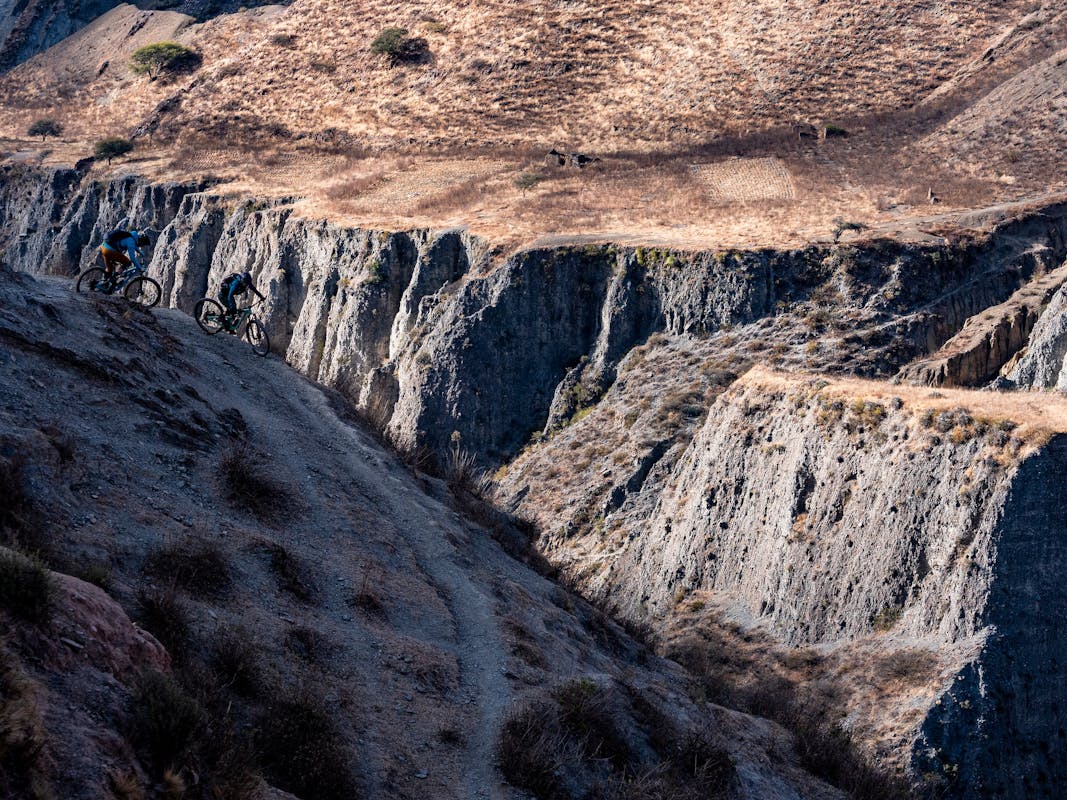
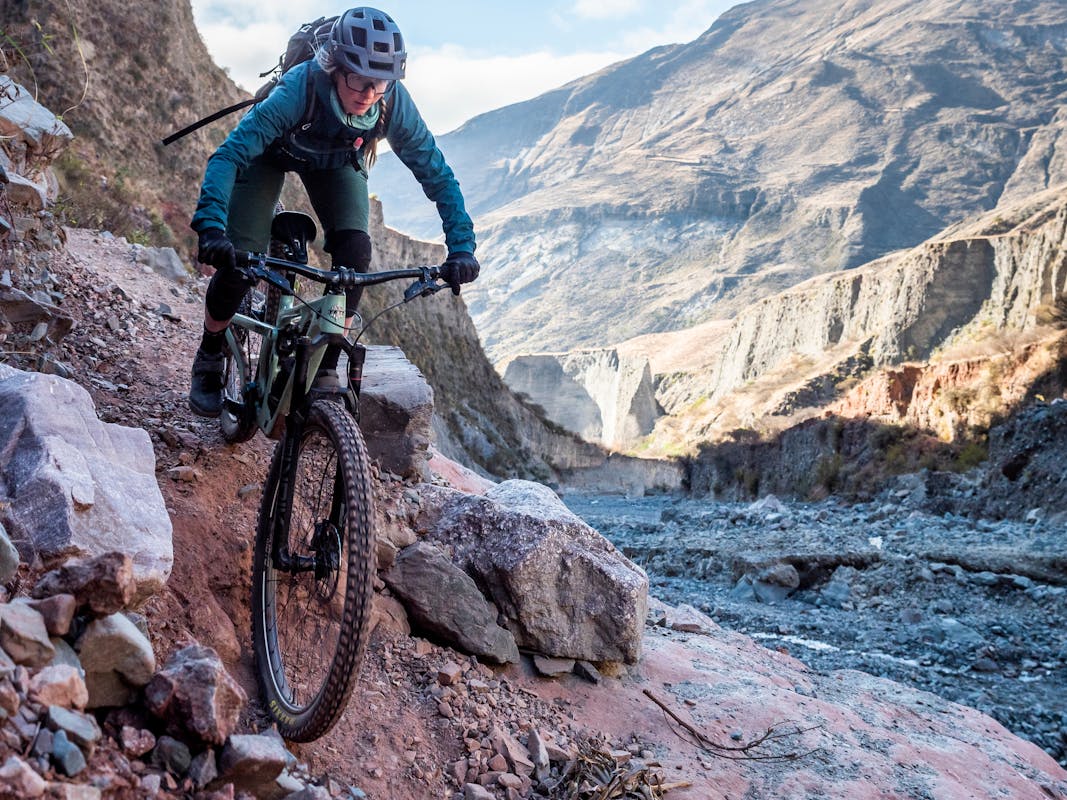
Francisco reminds us to fill up our water bottles at the next riverbed. We won’t be hitting drinkable water until we make it to what Dan keeps referring to as “Alberto’s Pimp Palace”. As I put one foot in front of the other with a fully loaded pack of fresh water, I imagine a Taj Mahal in the middle of nowhere: a giant bowl of kale salad waiting for me, kombucha on tap, a sauna, and llamas decked out in gold tapestries. A girl can dream, right?
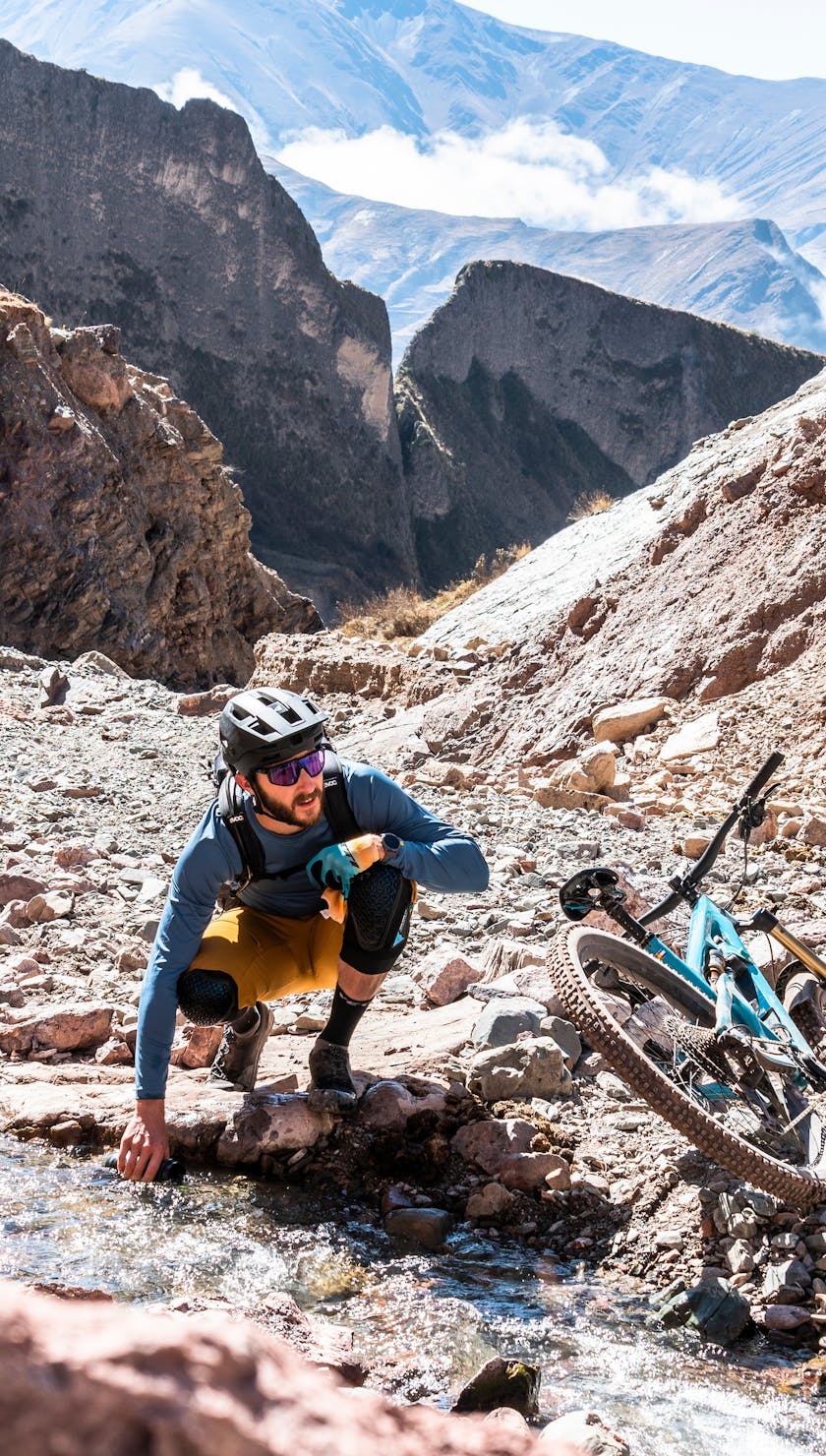
A few snack breaks later, we have lost sight of vegetation and enter a lunar-like landscape. When I think of adventuring through Argentina’s badlands, this is where I would find myself. Evidence of infrequent but heavy rainfall scares the hillsides. The impermeable soil crunches under our tires, and I reverse engineer hours until sunset to estimate the remaining time and effort based on Francisco’s description: “Just to the top of the pass, a techy but short descent, and then traverse that climbs slightly uphill to Alberto’s Pimp Palace.”
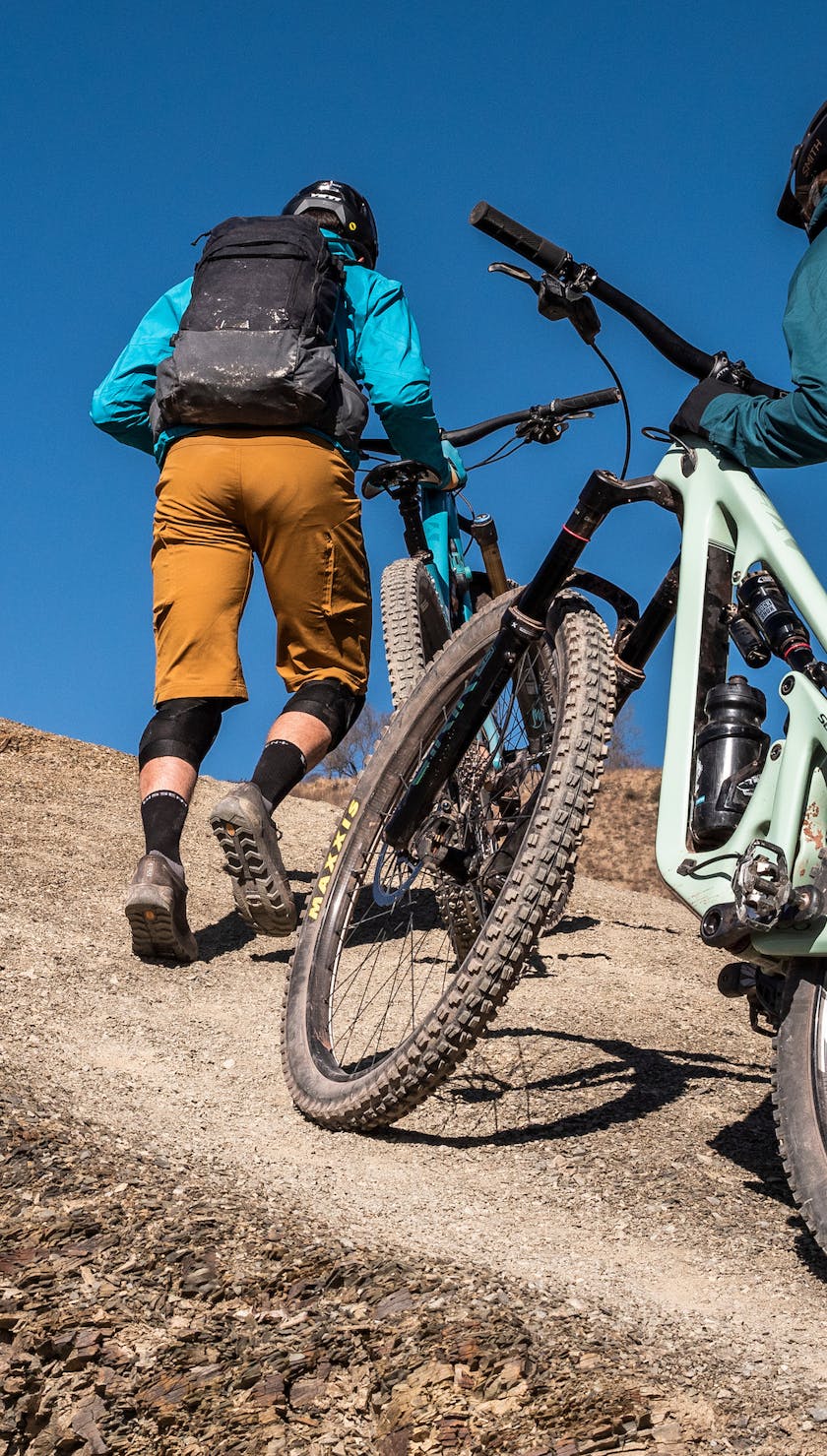
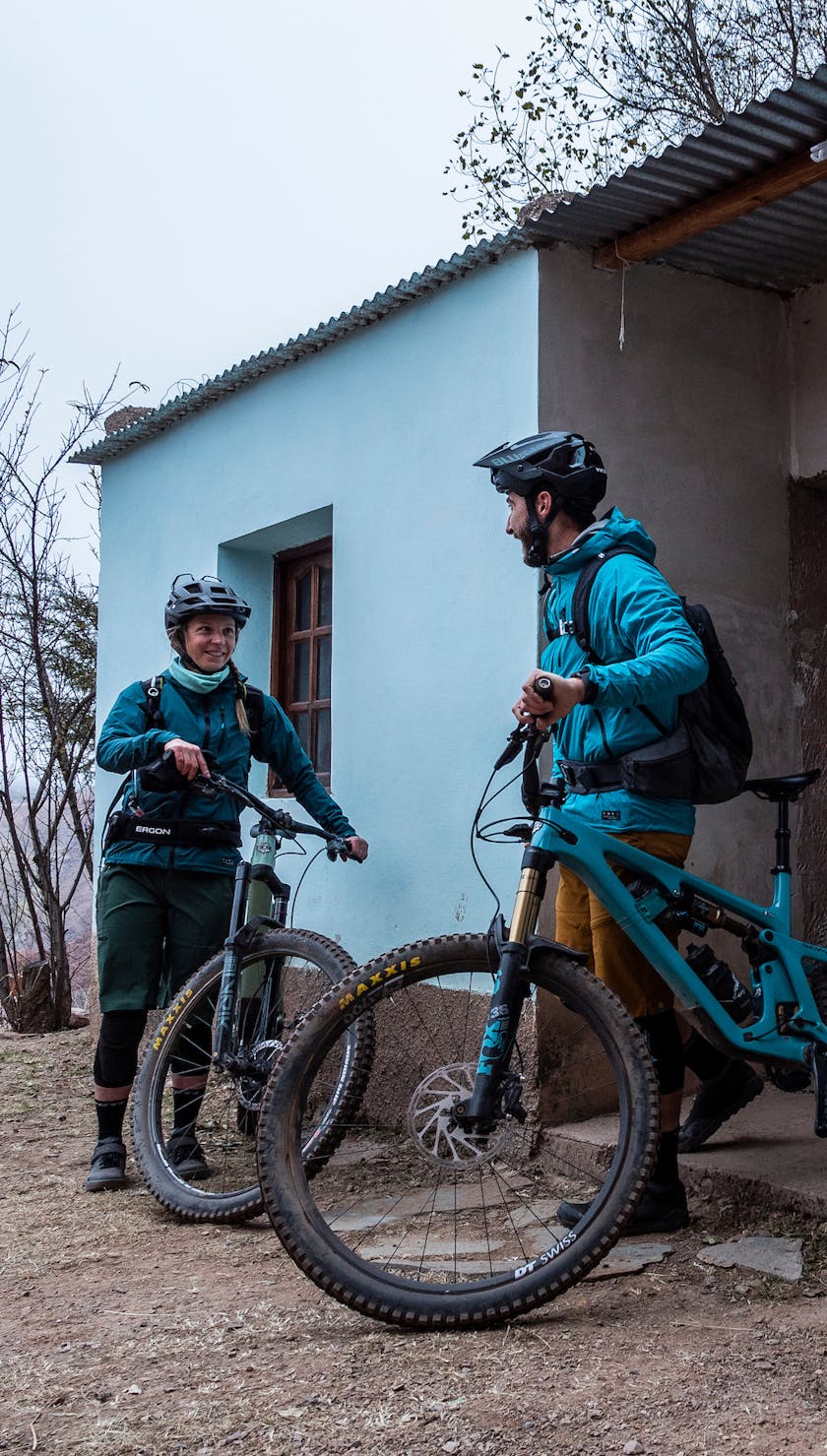
A steady rhythm kicks in and the group settles into our unique pedaling paces for what feels like the first time of the day. Counterintuitively, as we gain elevation, color infuses back into the landscape. Vibrant green weaves itself into the hillside, tantalizing us to the top of the pass where lunch awaits us.
Augustine and Jorge have been following our progress on roads and 4x4 tracks while Francisco rides sweep. While these trails have been used as routes to get from village to village for centuries, the first documented people to connect this traverse via mountain bikes were Francisco and Augustine on a scouting mission. It’s not lost on us the immense privilege to be able to travel through this breathtaking terrain with mechanized assistance, purely in search of adventure and perspective when these same trails have been essential to sustaining life. All together, we devour a thoughtfully-packed lunch of rice, vegetables, and you guess it: llama. Jorge pulls out two medium-sized wheels of goat cheese. “We brought one for Sarah and one for everyone else,” he jokes. Two days in and everyone had picked up on my appetite for queso de cabra.
Francisco’s summary for the remainder of our journey is spot on, but my tired body thinks differently. Less spry than this morning on a few technical chutes and exposed corners that would normally feel in my wheelhouse, I’m eyeing a side cut across the valley that I’m hoping leads us to our Taj Mahal. We cross a large, dried riverbed and I discern that the steep embankment in front of me leads to yet another hike-a-bike. “Just keep swimming … just keep swimming … you’ve done this for seven hours already, what’s another hour?”
Luckily, the hike-a-bike tempers into pedalable trail and we arrive at the small village of Chiyayoc about 15 minutes before sunset. A lovely couple by the names of Pedro and Martina greet us upon our arrival and show us to our rooms where we drop our packs in anticipation of dinner. Sounds of goats, sheep, llamas, and donkeys echo at 10,170 feet, any one of which could be on the menu tonight.
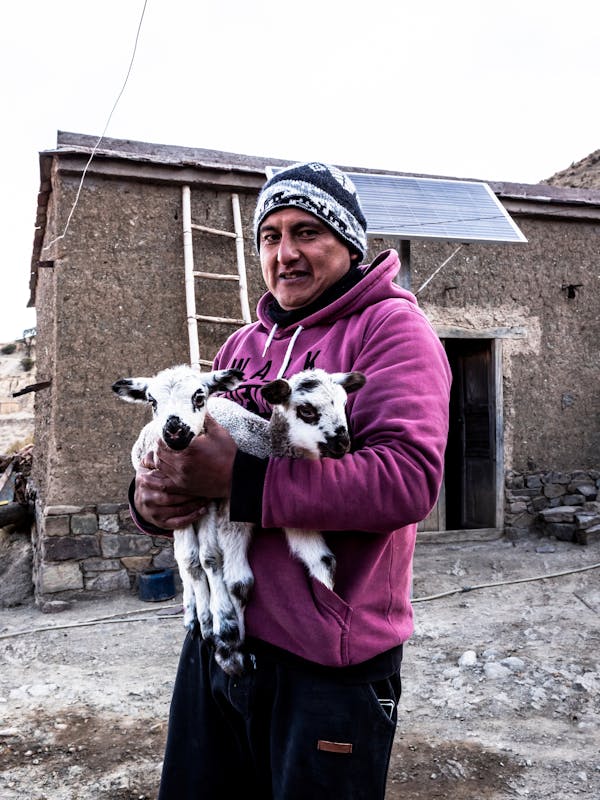
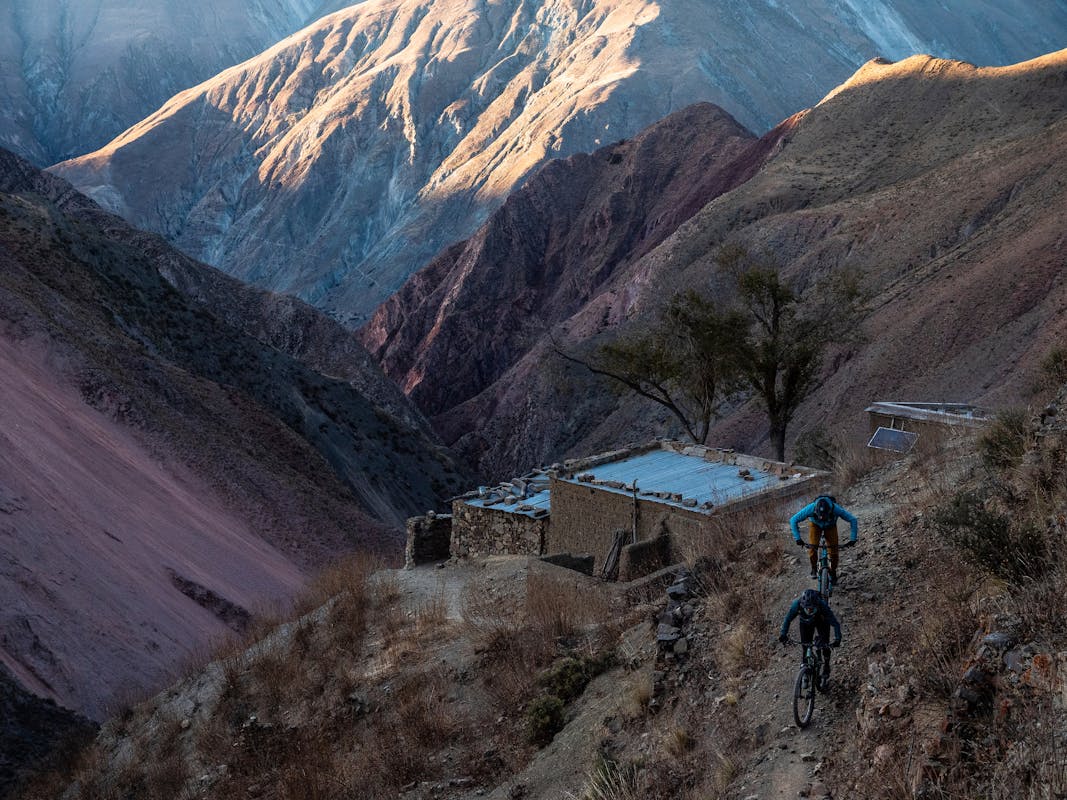
We’re invited down to the communal kitchen for maté cocido (a mixture of yerba maté tea and coffee beans) where we’ll finally meet the one and only Alberto. Weathered by decades of living in the high valley of Iruya, Alberto’s wrinkled skin alludes to his wisdom within. He built the very walls surrounding us and without conversing much, it is clear that his existence is embedded into the land. Distracted by the popping sunset, I nearly walk face-first into sheep organs hanging from a clothing line.
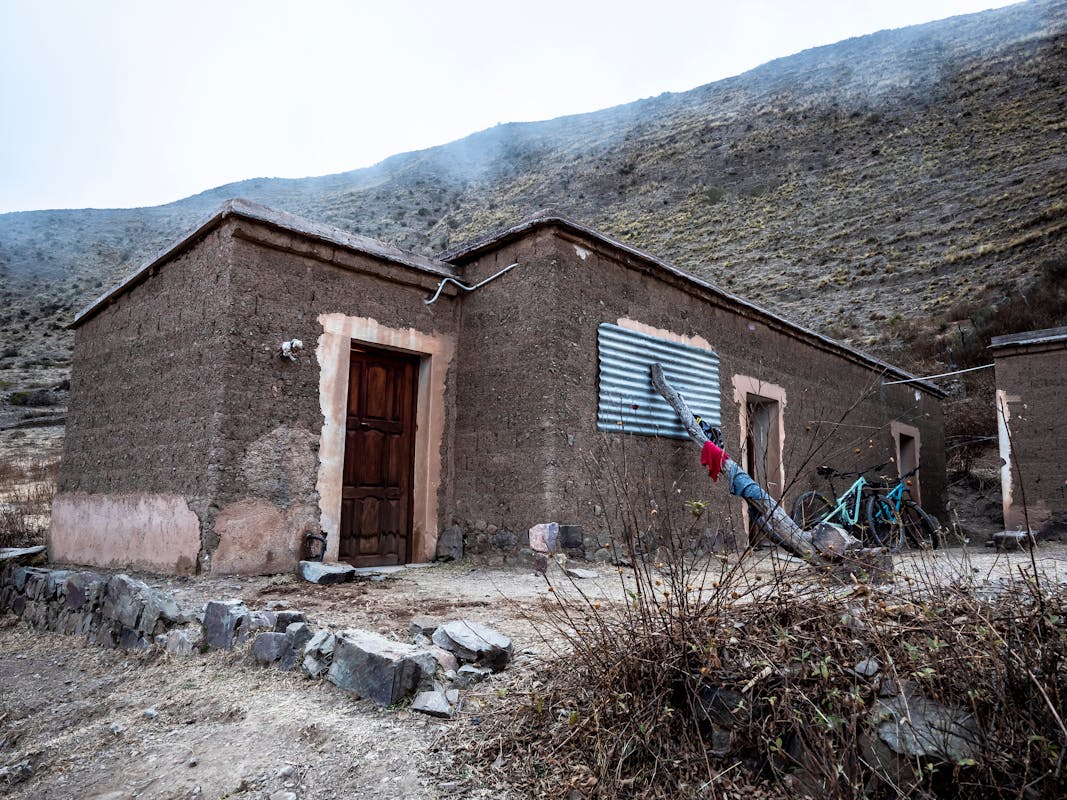
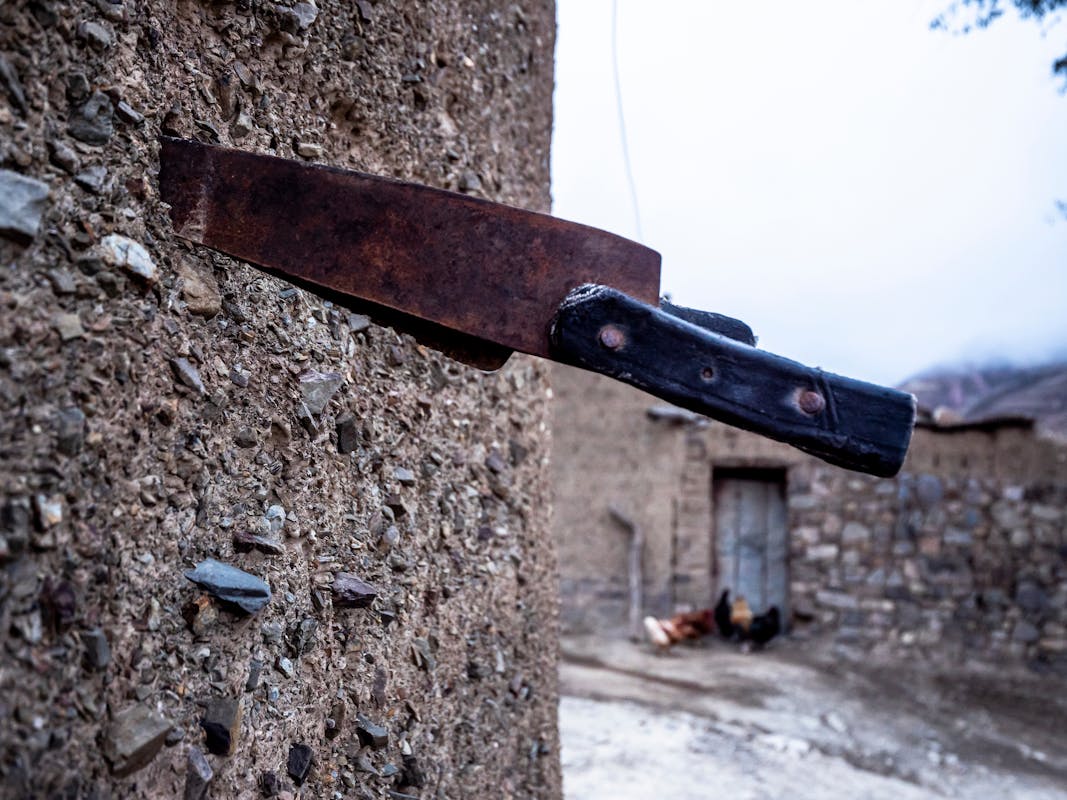
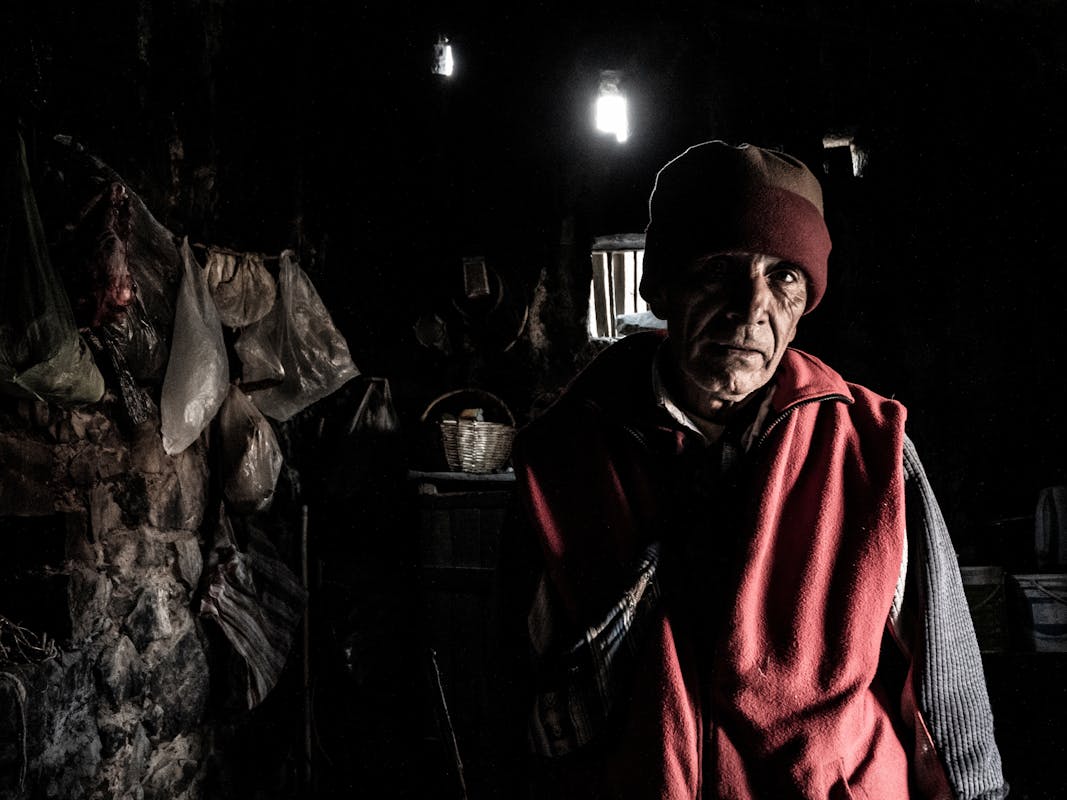
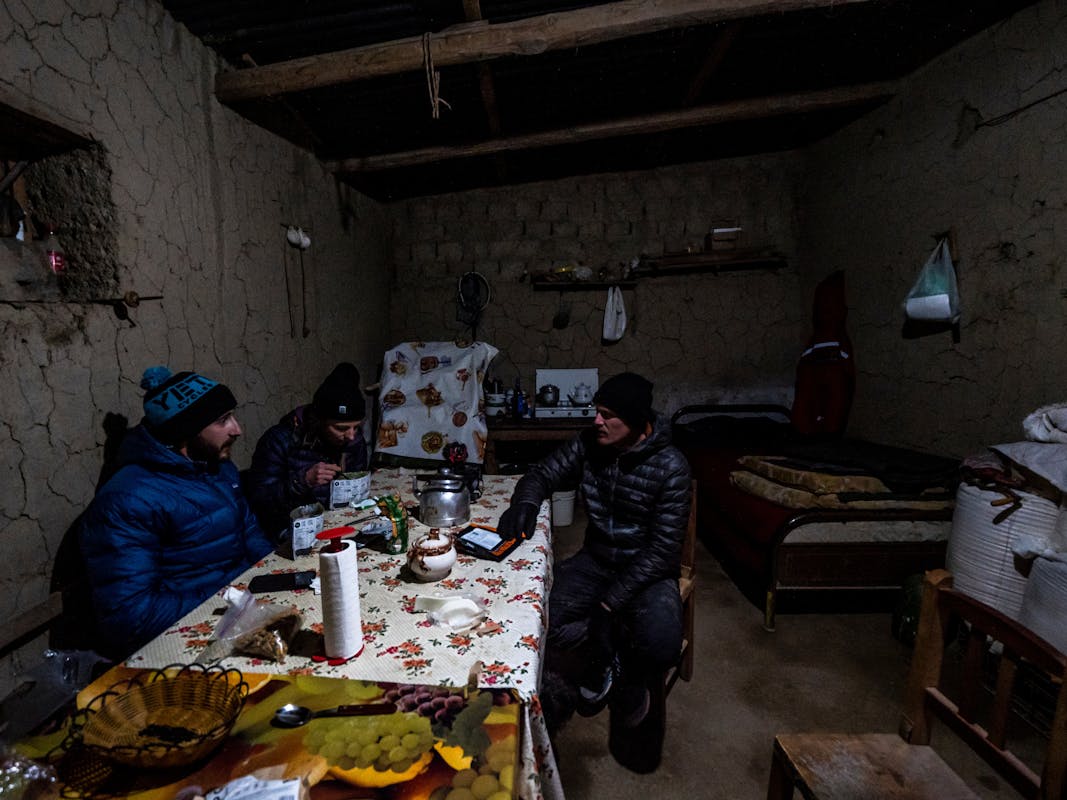
There may not be Wi-Fi at Alberto’s, but we are greeted with generosity that warms us inside and out — a simple yet hearty meal fresh from the courtyard, and tonight the lights can stay on all evening, encouraging a late night of drinking wine and deep conversations. Instead of being powered by a generator, electricity is produced by solar panels provided at no cost by the government to small villages such as Chiyayoc and its surrounding neighbors. Practical, sustainable, and clean. Life up here feels simple and pure.
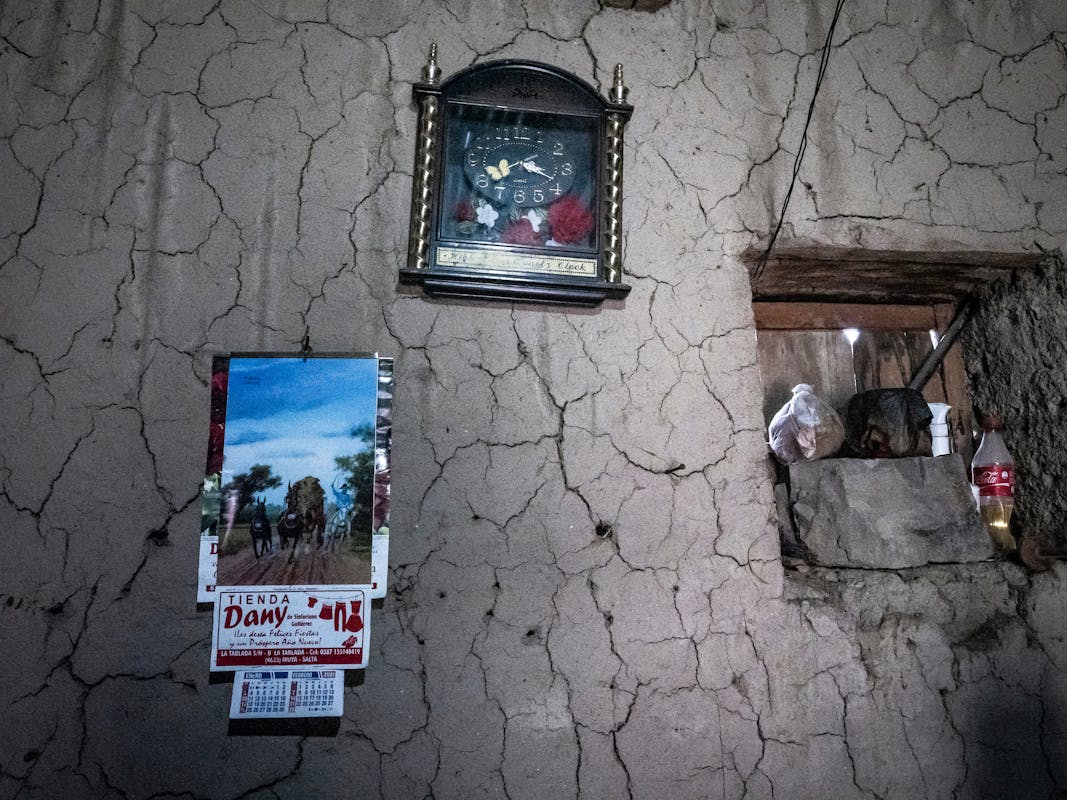
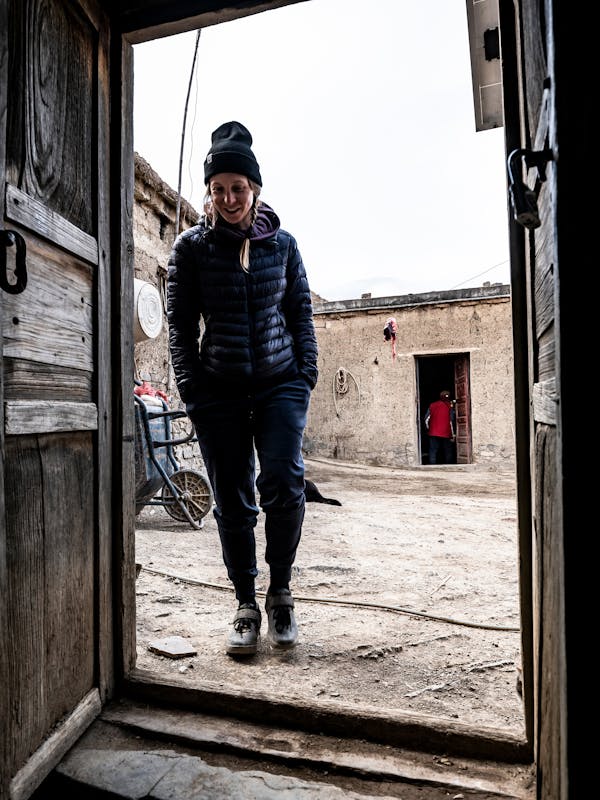
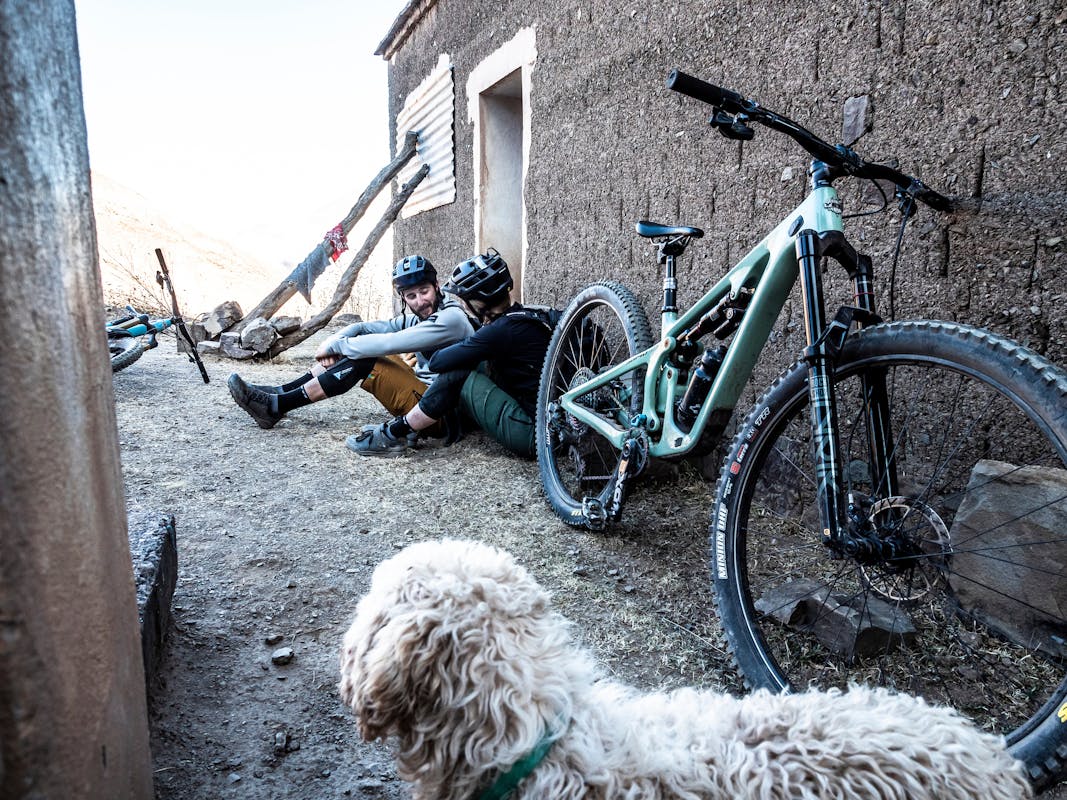
LLAMA SALAMI
We wave goodbye to Alberto, Pedro and Martina and continue our journey towards Iruya. It’s Day 3 and the sensations of pulling on the same wool jersey, crusty knee pads, and shouldering a pack become the norm. As the crow flies, we’re less than nine kilometers from our destination, but with the unknown topography ahead, it may as well be a marathon. Out of the gate, the best section of trail awaits us: a fast, downhill traverse into soft, swoopy turns to the basin. Francisco points out Alberto’s summer pastures in the distance as we ride through his regime.
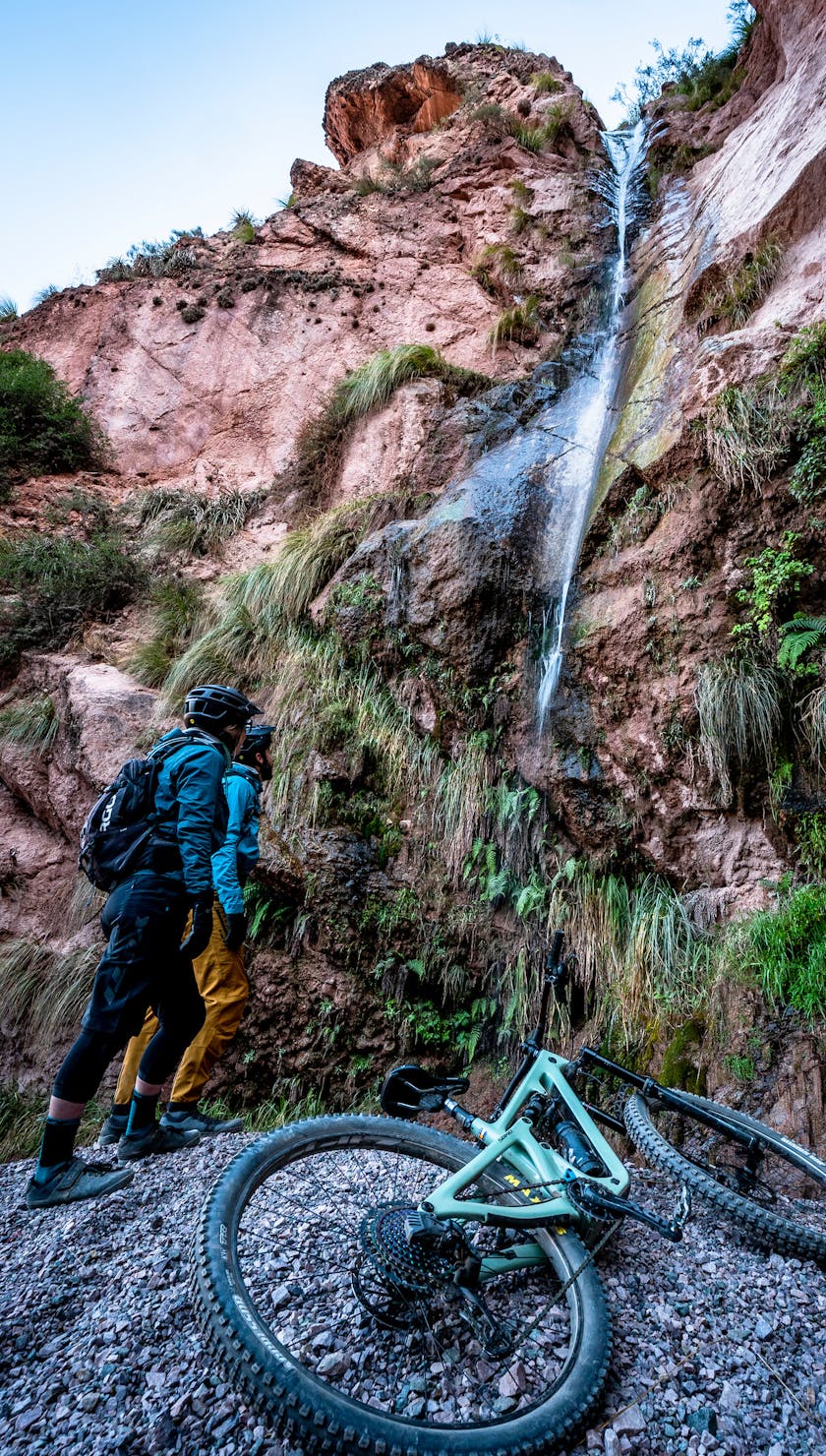
Par for the course, we hit a riverbed, this time with a trickier, more consequential crossing that involves some strategic maneuvering of big wheels between giant boulders. For a brief moment, I miss my 27.5” wheels. Then, straight into the obligatory hike-a-bike.
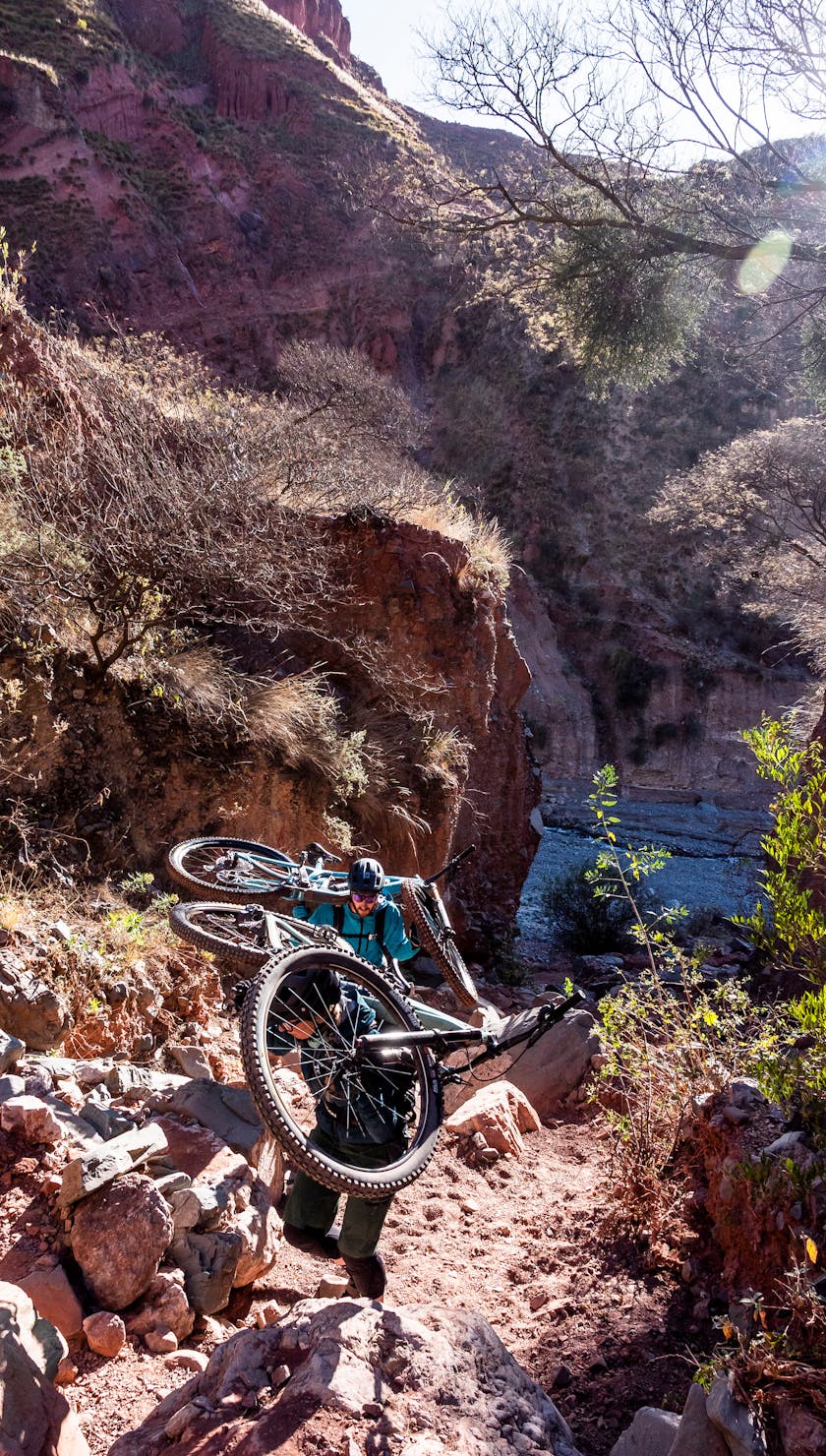
Like the previous days, the route consists of ascending and descending through mountain passes and river crossings, and on your terms, you move through your own highs and lows. But in a group, there is a good chance someone else will be at their peak when you’re at your valley.
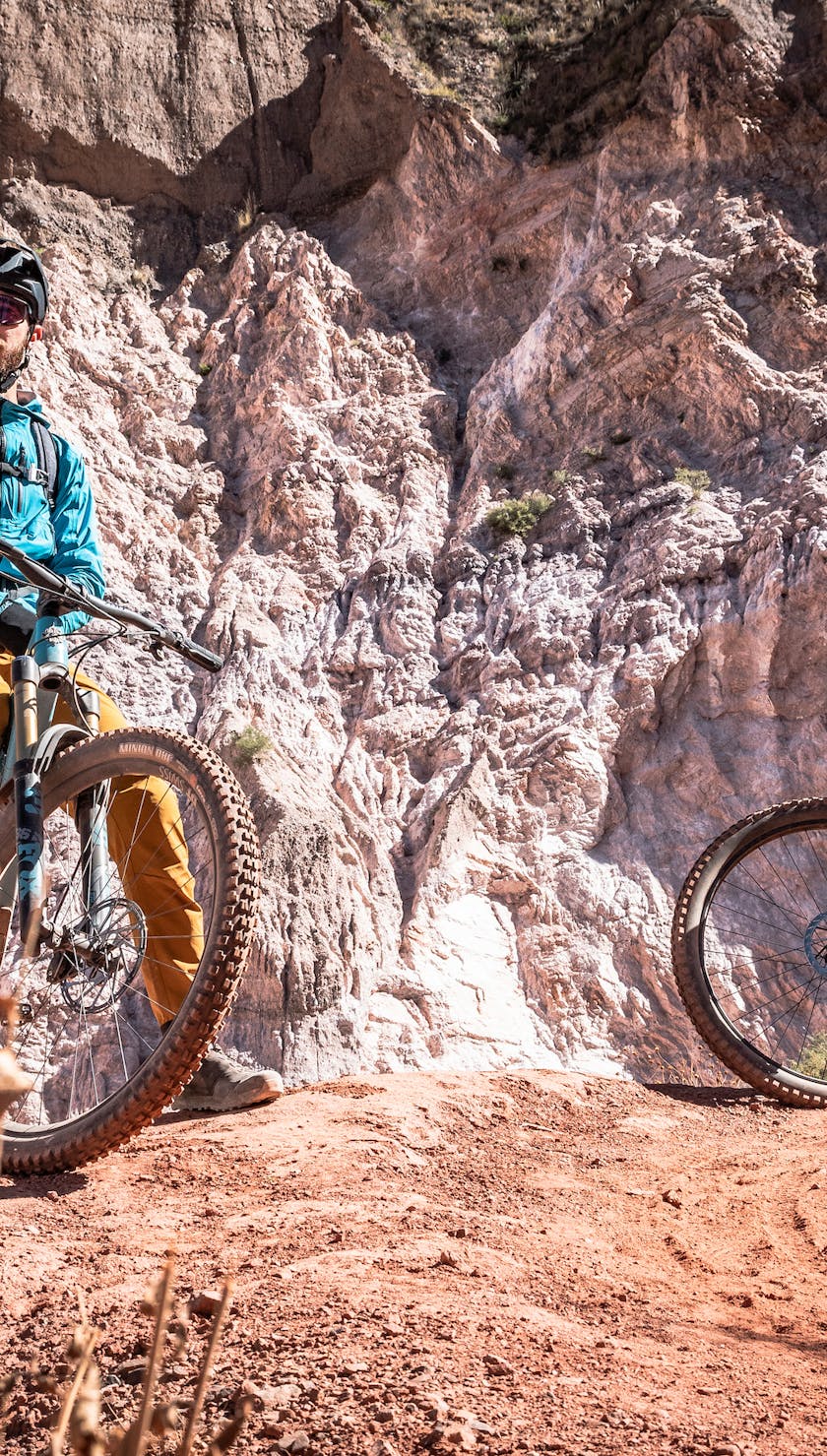
The entire trip, Francesco ran at a different pace. Literally, ran. You can take a guide out of their locality, but you’ll never take the thoughtfulness and concern for others out of a guide. Dan came down with a chest cold that is getting worse as the days wear on and it’s clear he needs more rest and medicine. As we near our second pass for the day, I can see Francesco’s long limbs sprinting toward me.
After a quick exchange to ensure that I’m comfortably plodding along, Francesco carries on to Dan who has fallen slightly behind to carry his bike for the remainder of the climb. While we all know Dan is tough as nails and this quest doesn’t even come close to his wildest adventures, a little relief can go a long way. We regroup at the top and Francisco reveals we are getting close to Iruya.
With one final descent to go, Francisco saved the best for last. The trail is steep, exposed, sharp, and committing, a challenge for even the most experienced Euro turner. Dan’s energy was clearly back to usual levels as he squealed in delight around each switchback. Francesco was simply out of sight.
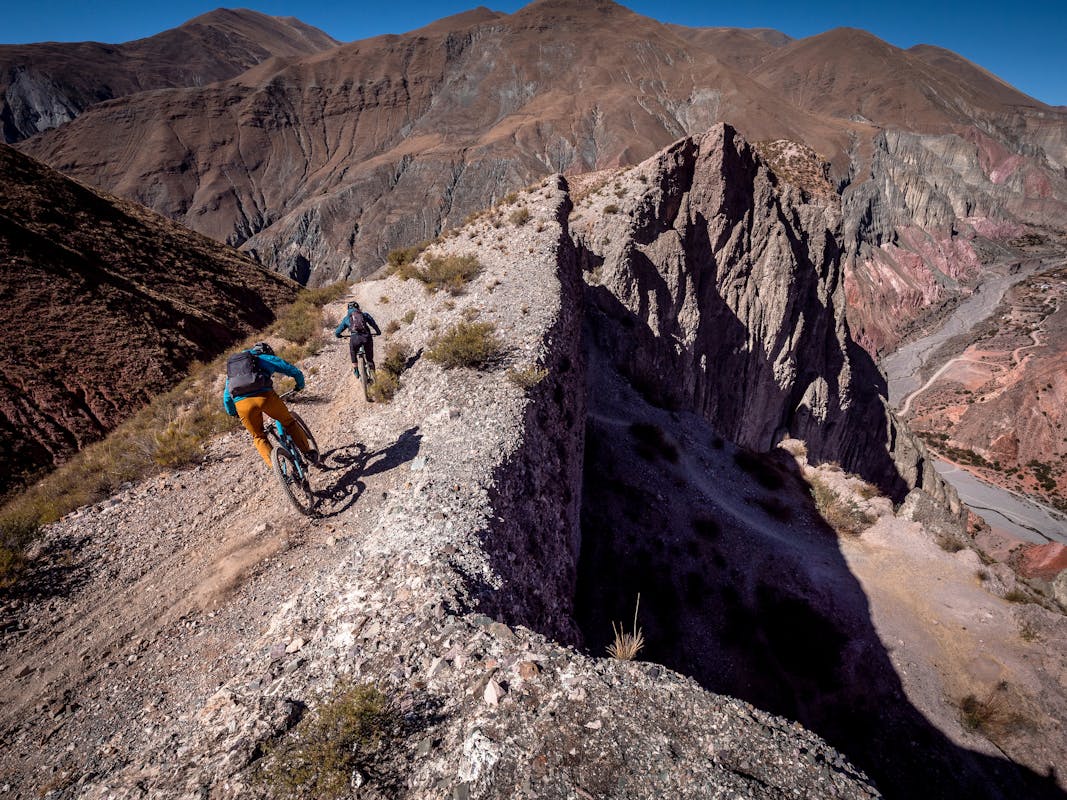
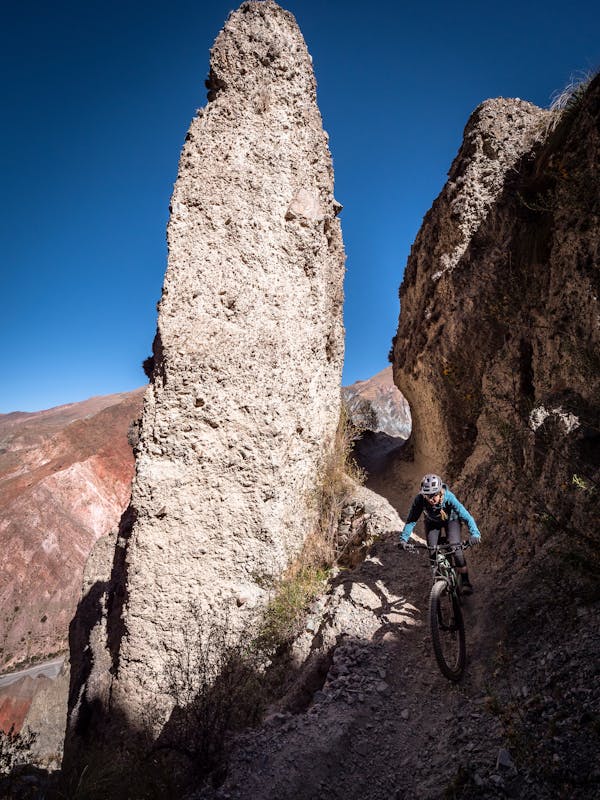
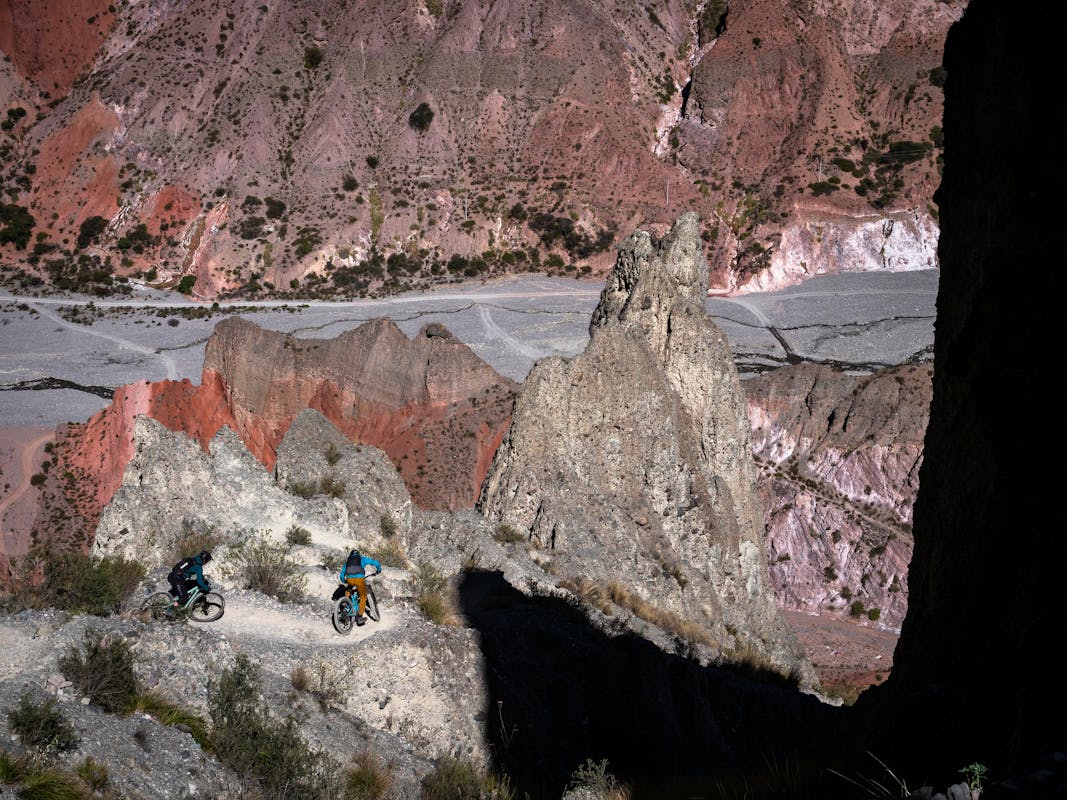
We hit the outskirts of town and begin the pedal towards a cold limonada and massive lunch. At this point, even if it was llama salami, I would be content. I notice a couple walking in the riverbed and my jaw drops.
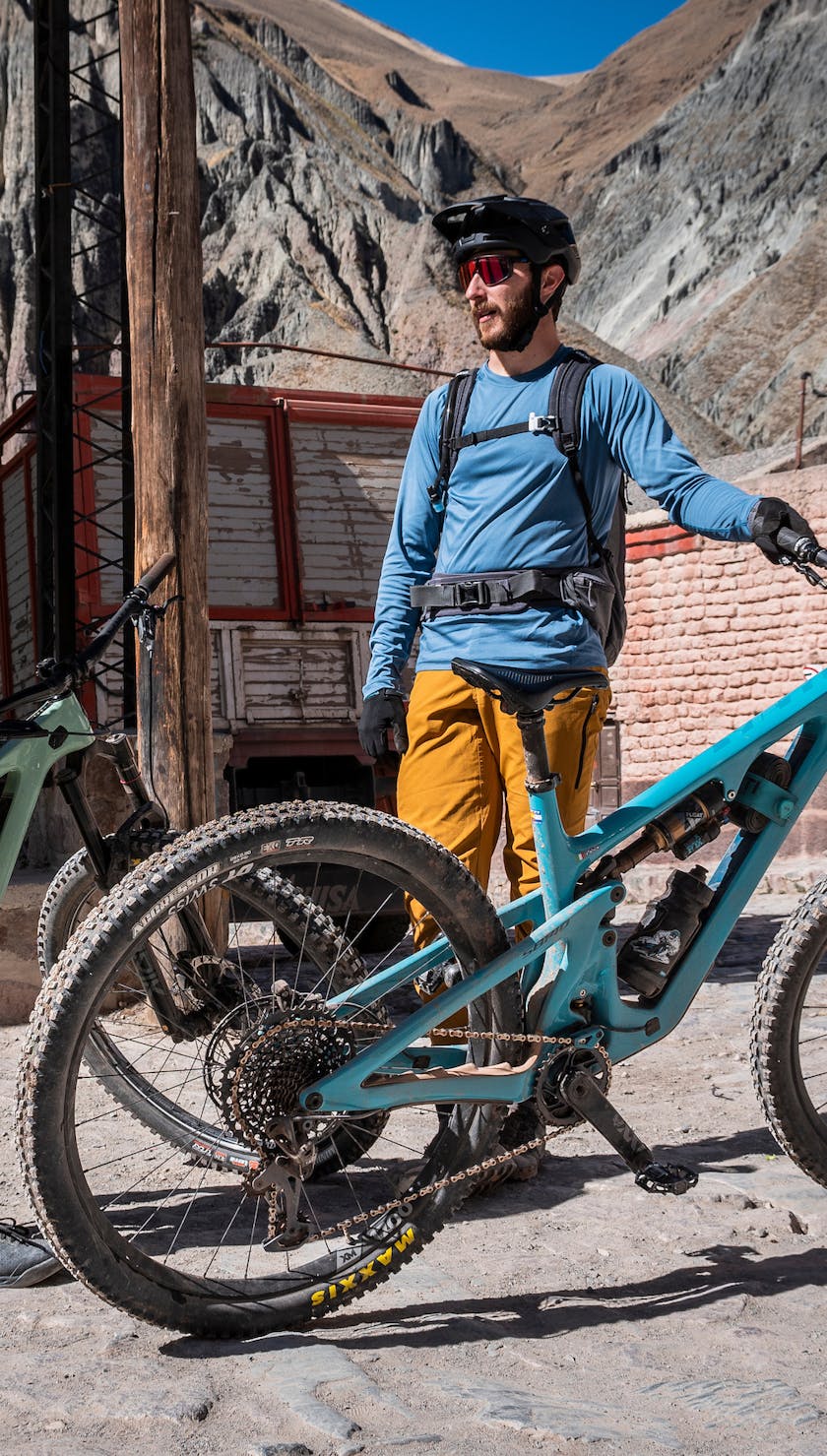
It’s Pedro and Martina. In the same five-hour time span, they had walked from Chiyoyac to Iruya. Francisco relays that in the drier winter months, you can travel through the riverbed and it’s a much quicker route than the one we rode. Pedro and Martina work in the town of Iruya during the week to earn money so their son can attend school. On the weekends they hike back into the mountains to replenish supplies, enjoy the peace and simplicity of their mountain abode, and meet travelers like us seeking out homestays. It’s become a way of life for them, and this half-day hike is their norm.
A VALLEY RICH IN CULTURE
We enter Iruya as tired, dusty mountain bikers looking for reprieve and with an appetite for everything under the sun. We leave with an appreciation for the people who have created a home in this harsh environment to keep their traditions alive over the past 250 years.
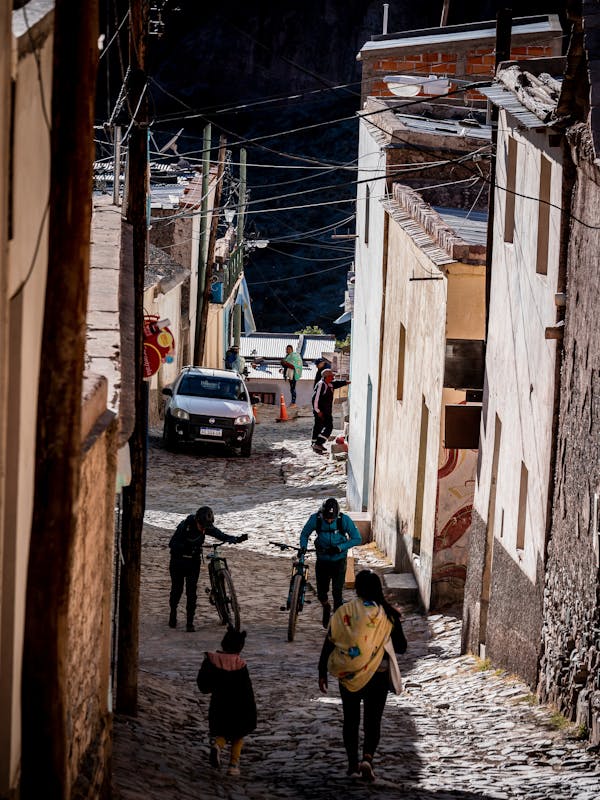
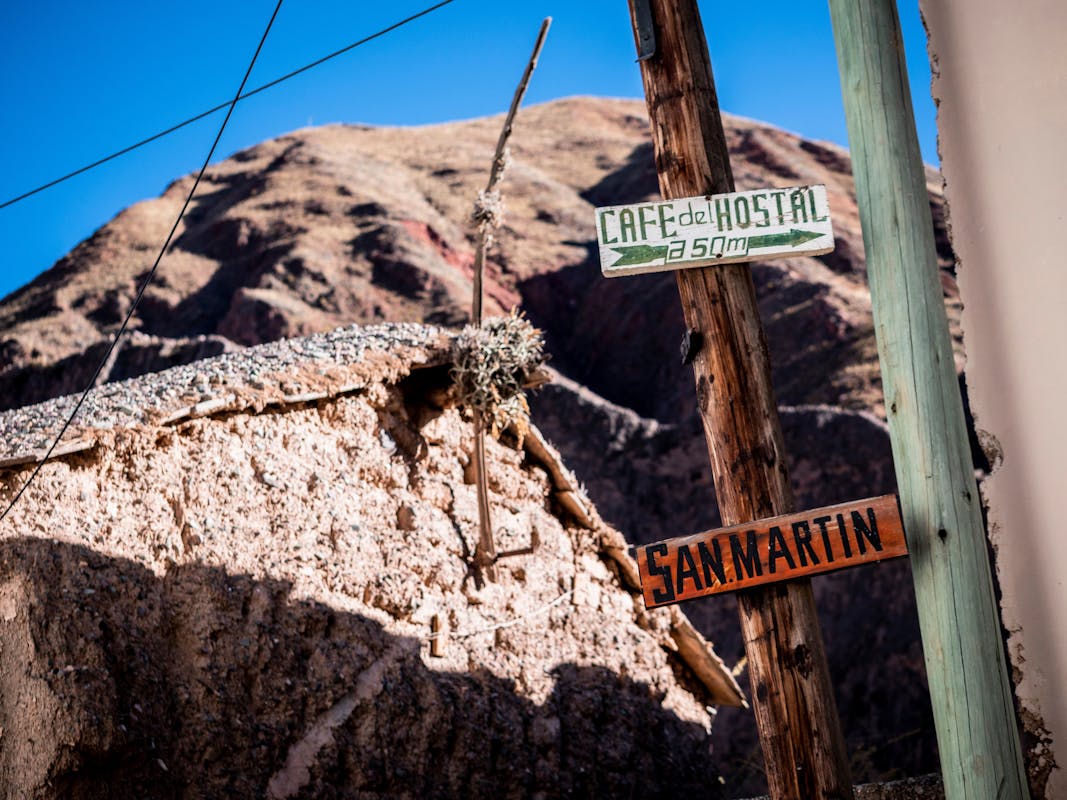
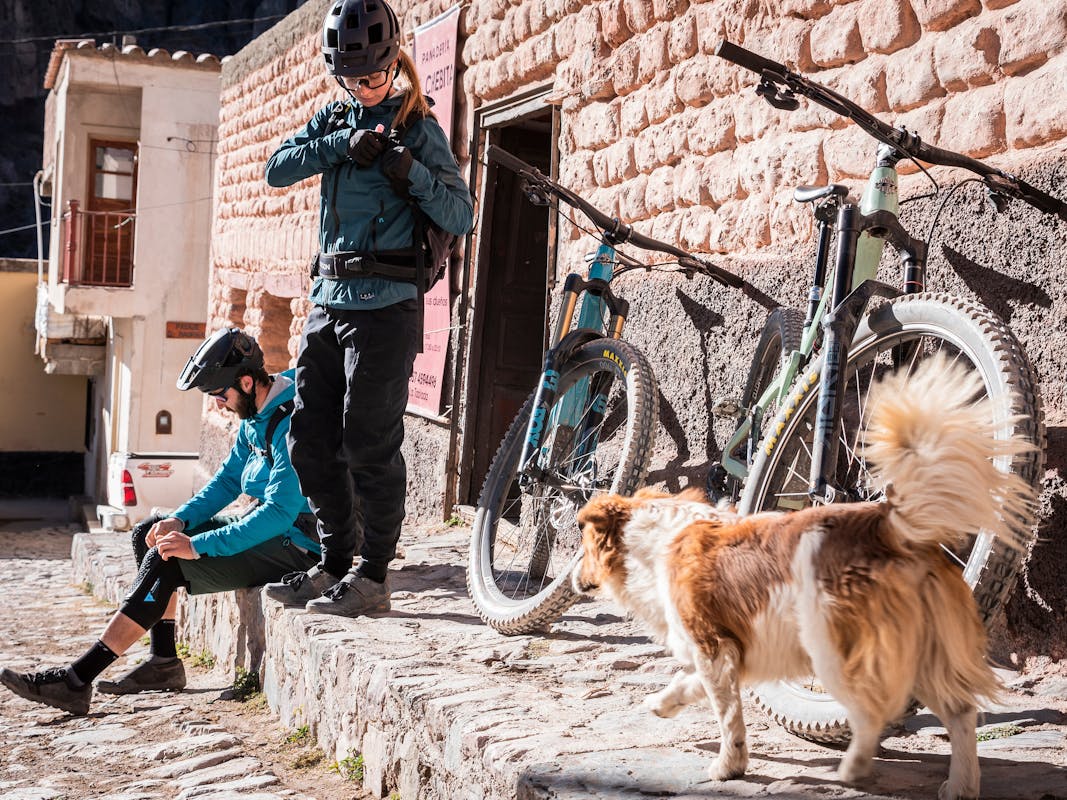
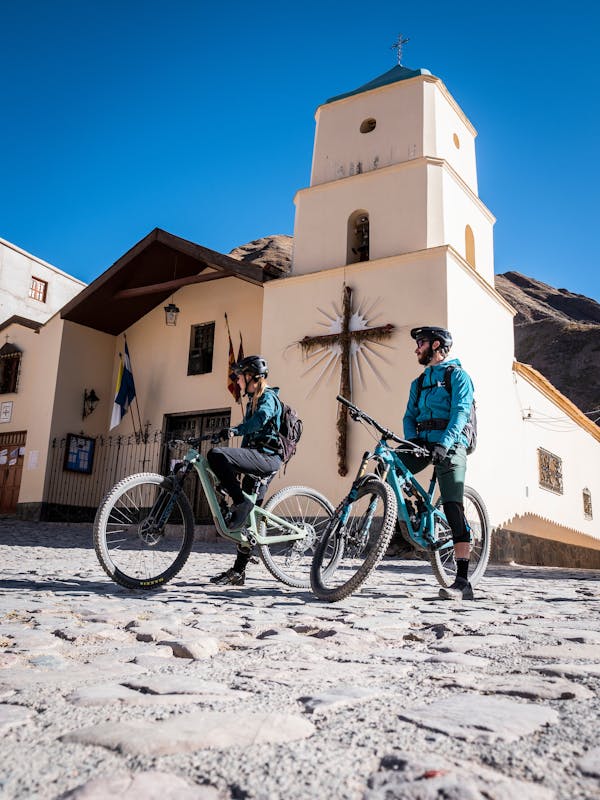
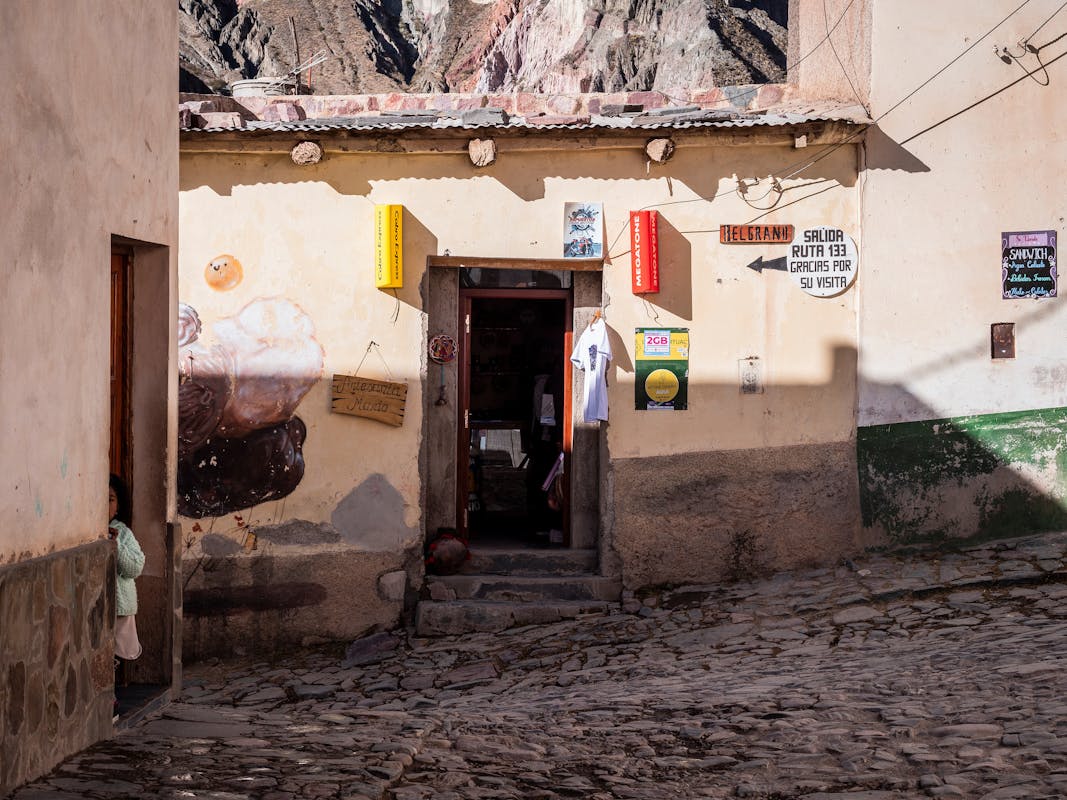
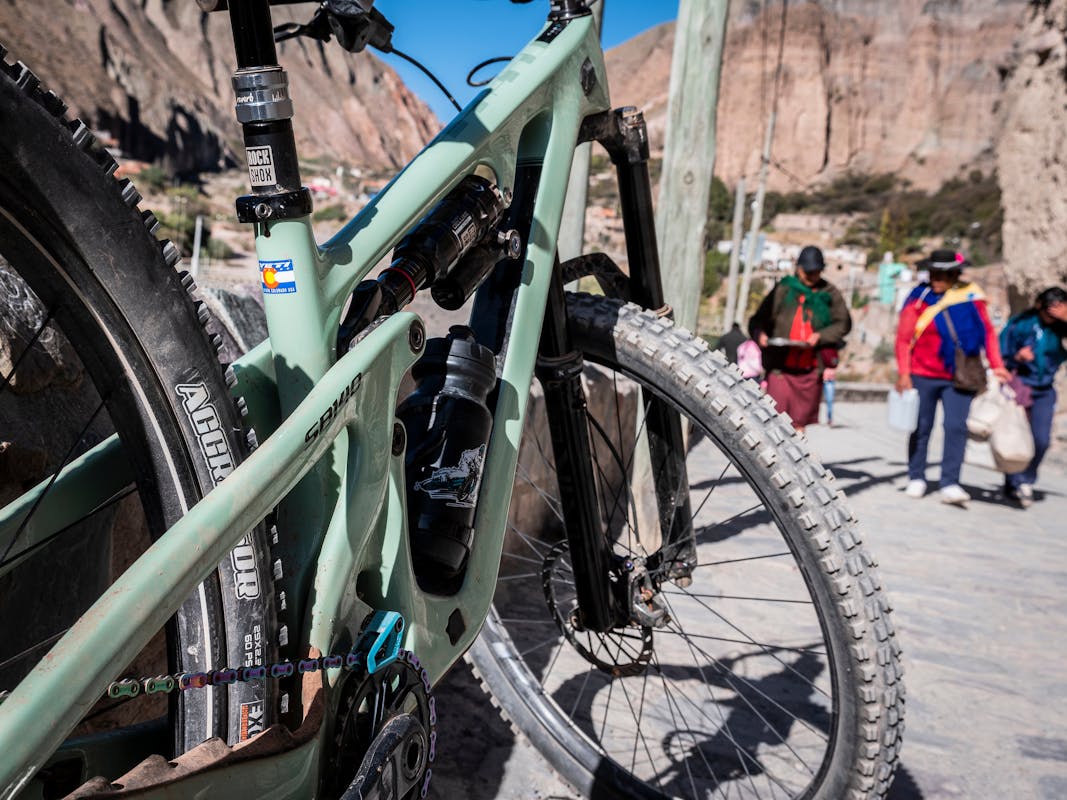
While Iruya is a known tourist destination, you won’t find the run-of-the-mill craft stands selling trinkets and cliché goods. The people you see with their colored clothes and brimmed hats made with their own hands are genuine. They aren’t dressed up to attract tourists. Iruya preserves its narrow and cobbled streets, and houses constructed of adobes, stone, and straw. Even the church, built in 1690, 63 years before the town was officially founded, remains a fixture in the center of town with original paintings and décor intact. I did not glean details about Pedro, Martina, and Alberto’s lineage, but it is very clear their connection to the land, traditions, and way of life runs deep.
The natural beauty of Iruya beckons us to tack on more exploring, but everyone is ready to soak up a full day of rest before we begin our trek back to Tilcara on the one-way dirt road that during the rainy season is impassible. We have a few more iconic places to color in the lines of our visit to the Jujuy Province.
Just an hour up the road from Tilcara sits Serranía de Hornocal (the 14 Colored Mountain). Even from Google Earth, you can see the colorful phenomenon that was formed underwater 600 million years ago that now sits on top of the Andes at over 15,000 feet.
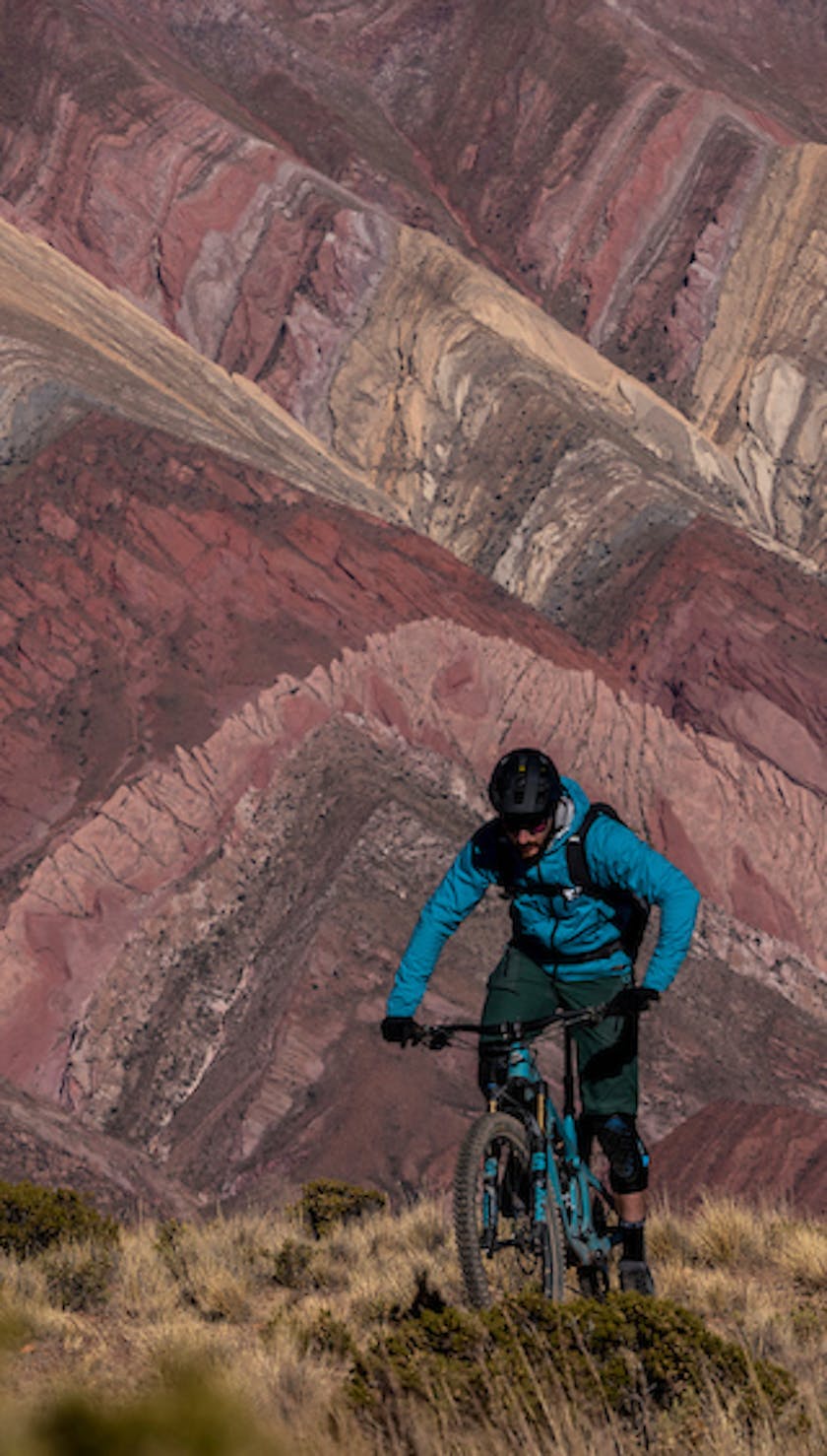
Located within the narrow mountain valley of Quebrada de Humahuaca, this area is protected as a UNESCO World Heritage site. Rolling through the dirt roads at over 14,000 feet to take in the views was simply enough. The sheer variety of colors painted across the landscape calls to be contemplated for a measure of time. An ancient Inca caravan road runs through here and for millennia, prehistoric hunter-gatherer communities have resided. The vicuñas we met along the way, relatives of the llama and wild ancestors of domesticated alpacas, have been roaming here since the last ice age.
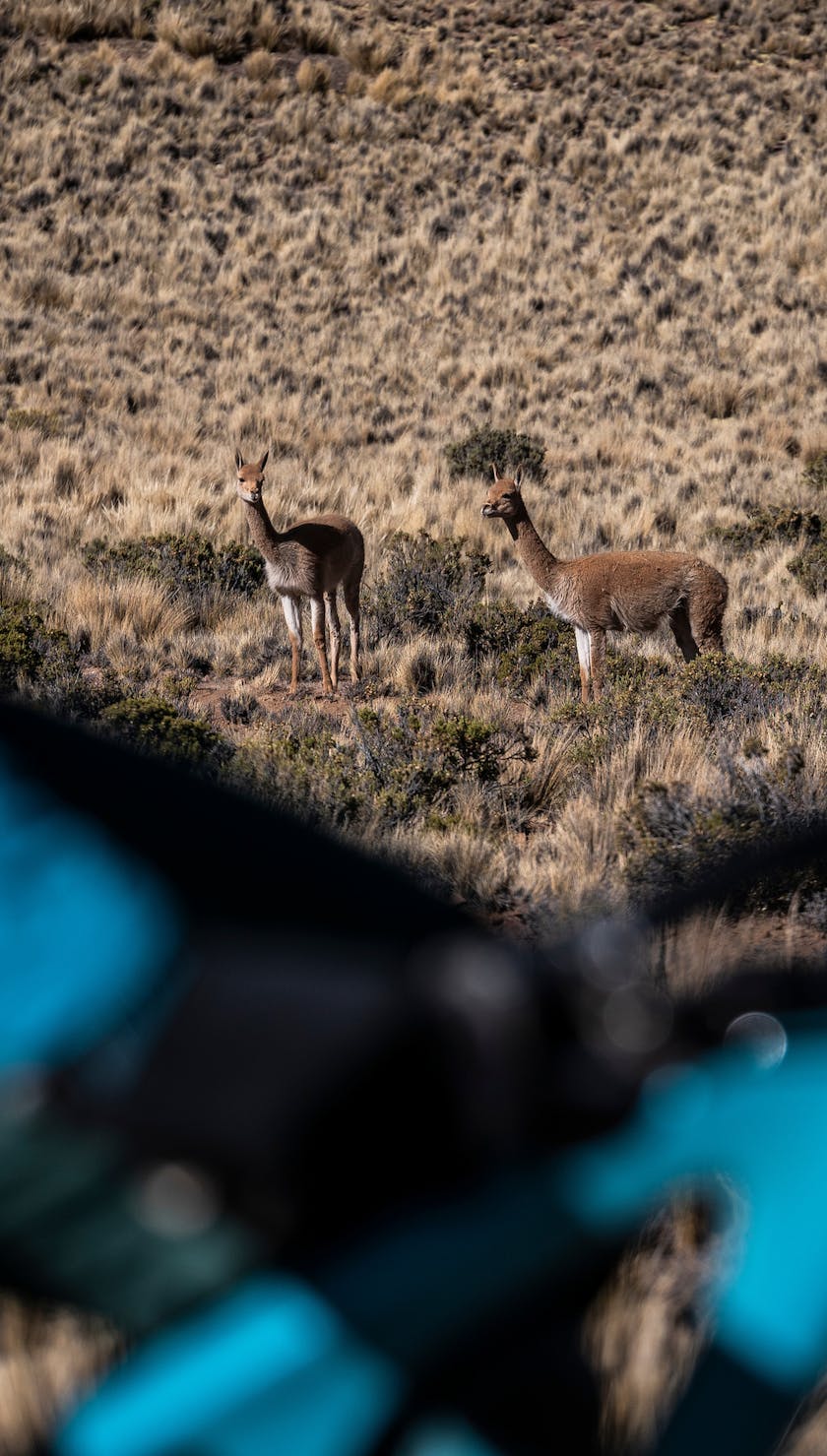
Not to be outshined, the Cerro de los Siete Colores (The Hill of Seven Colors) located in the nearby town of Purmamarca, offers more riding through its hills and a town rich in culture, local cuisine, artisans and open markets. Legend has it, when the small village of Purmamarca was formed, the hills had no color to them. To the imaginative minds of the young children who lived there, complacency was unacceptable. For seven nights, the children disappeared from their beds to paint the hillside with a new color—green, yellow, red, brown, purple, white, and pink. Since these seven nights, the hill has been completely covered in the seven colors that the children painted onto it and every year since, the town has a celebration in honor of painting the colorful hillside.
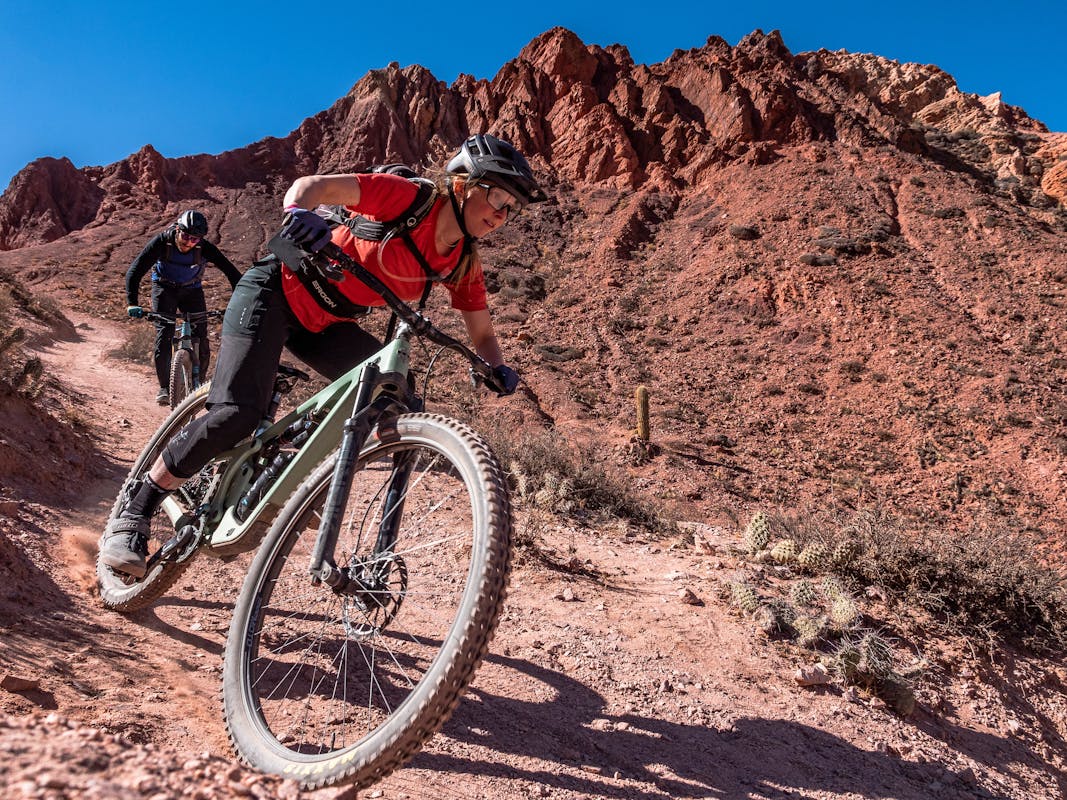
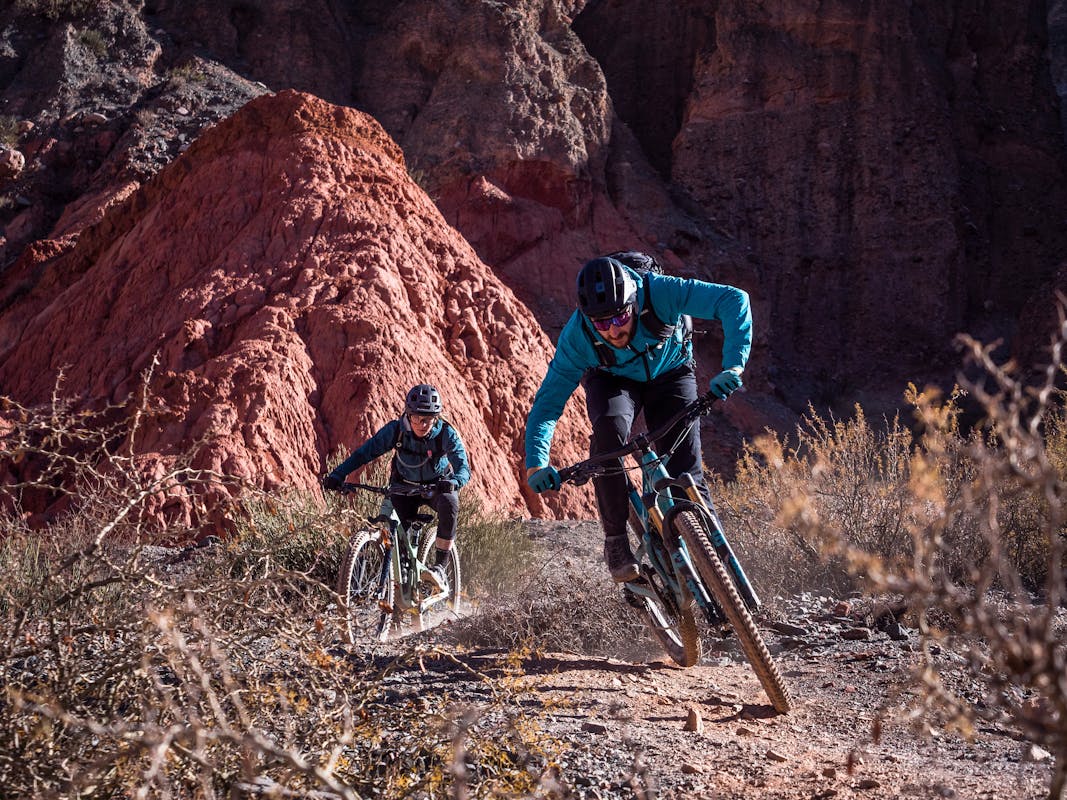
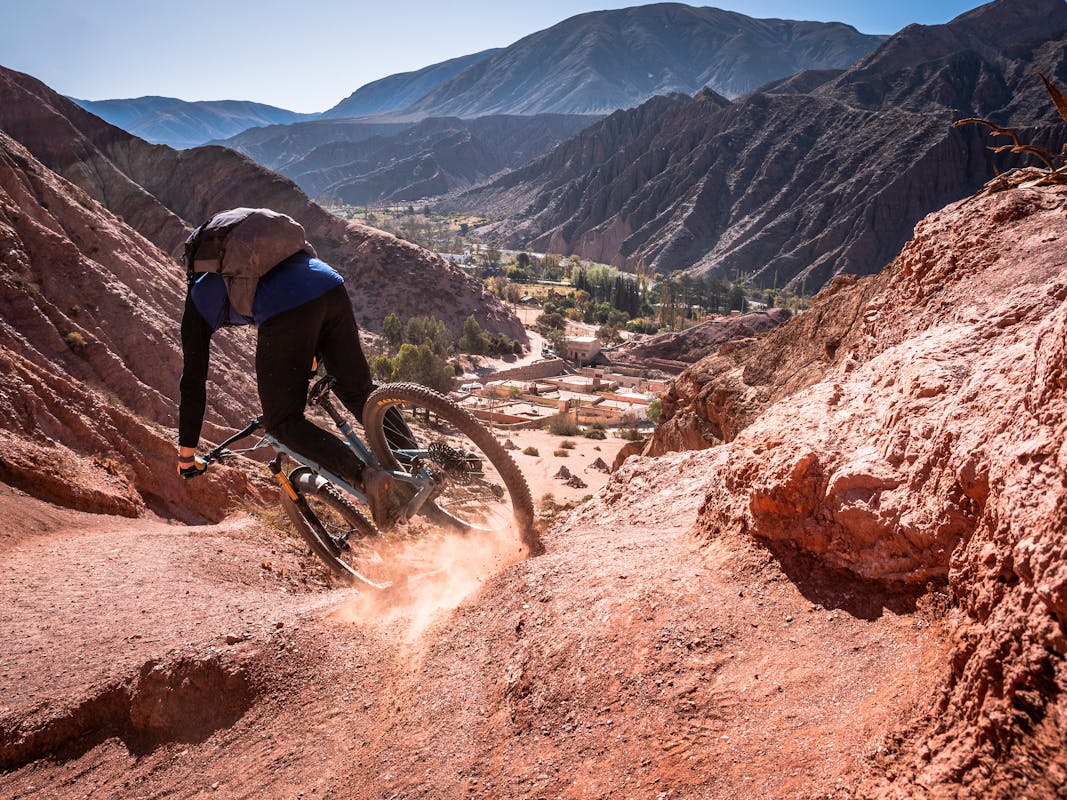
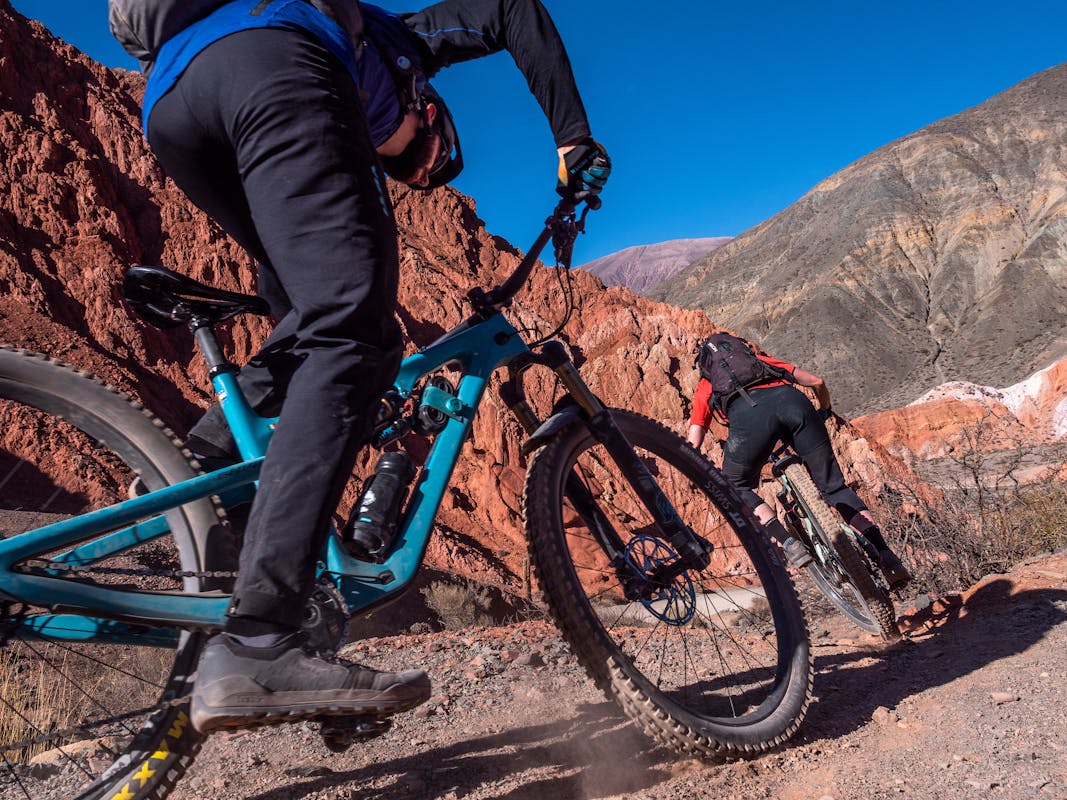
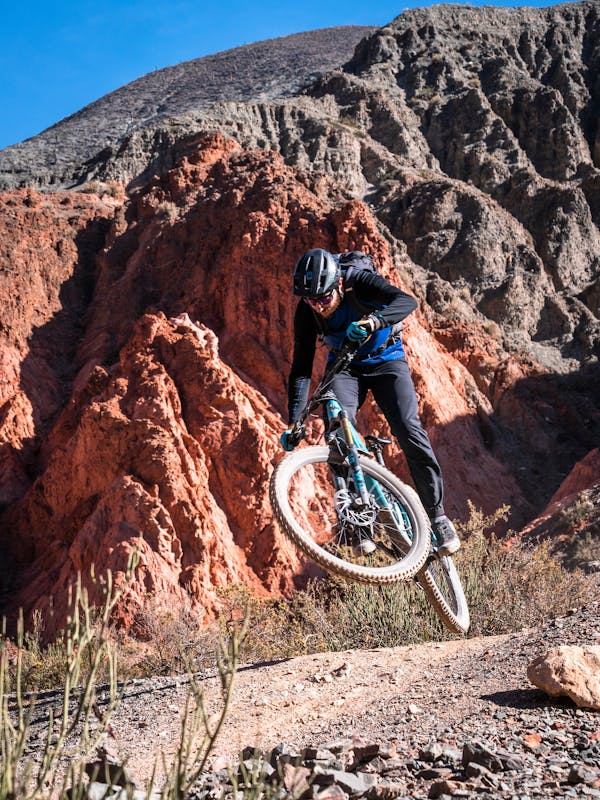
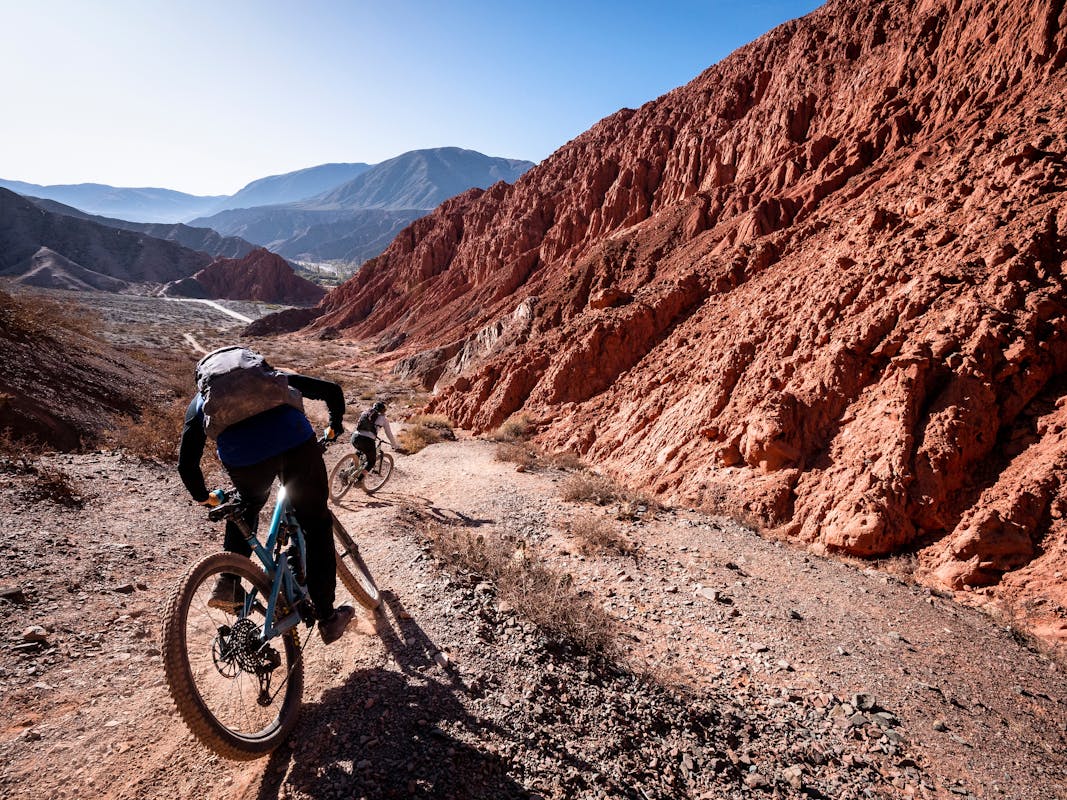
MARMITE
These types of adventures, as Dan Milner puts it, “are really like Marmite. People either love it or hate it.” We traveled across the globe to ride and hike-a-bike our way through an almost inhospitable environment, where the landscape has been scoured and eroded for longer than we can conceptualize and the trails are best suited for donkeys and foot traffic. But the people, their traditions, and their way of life continue to thrive in the badlands of Argentina, and their generosity radiates outwards. These are the lived experiences that make us shift perspective and our roots grow deeper.